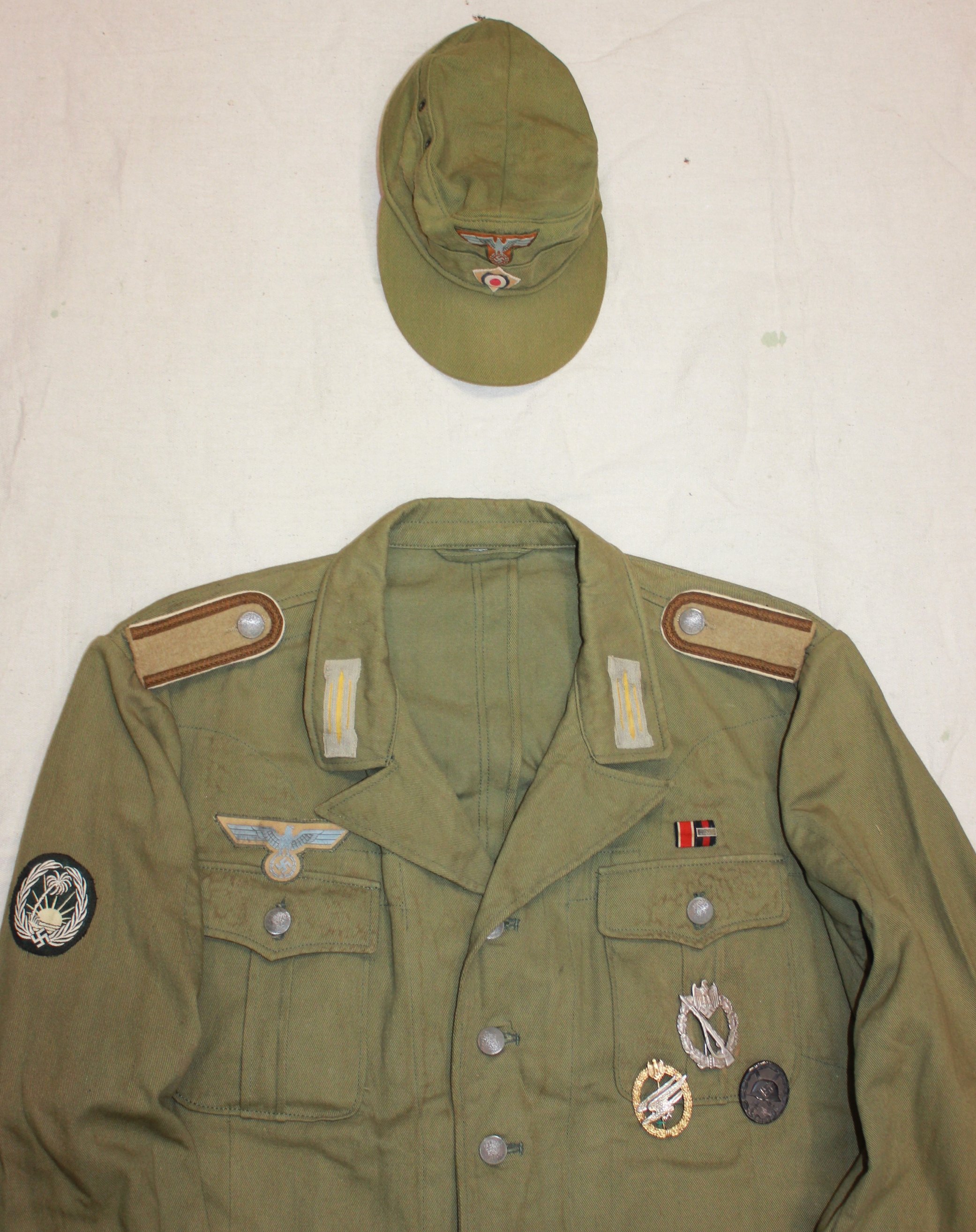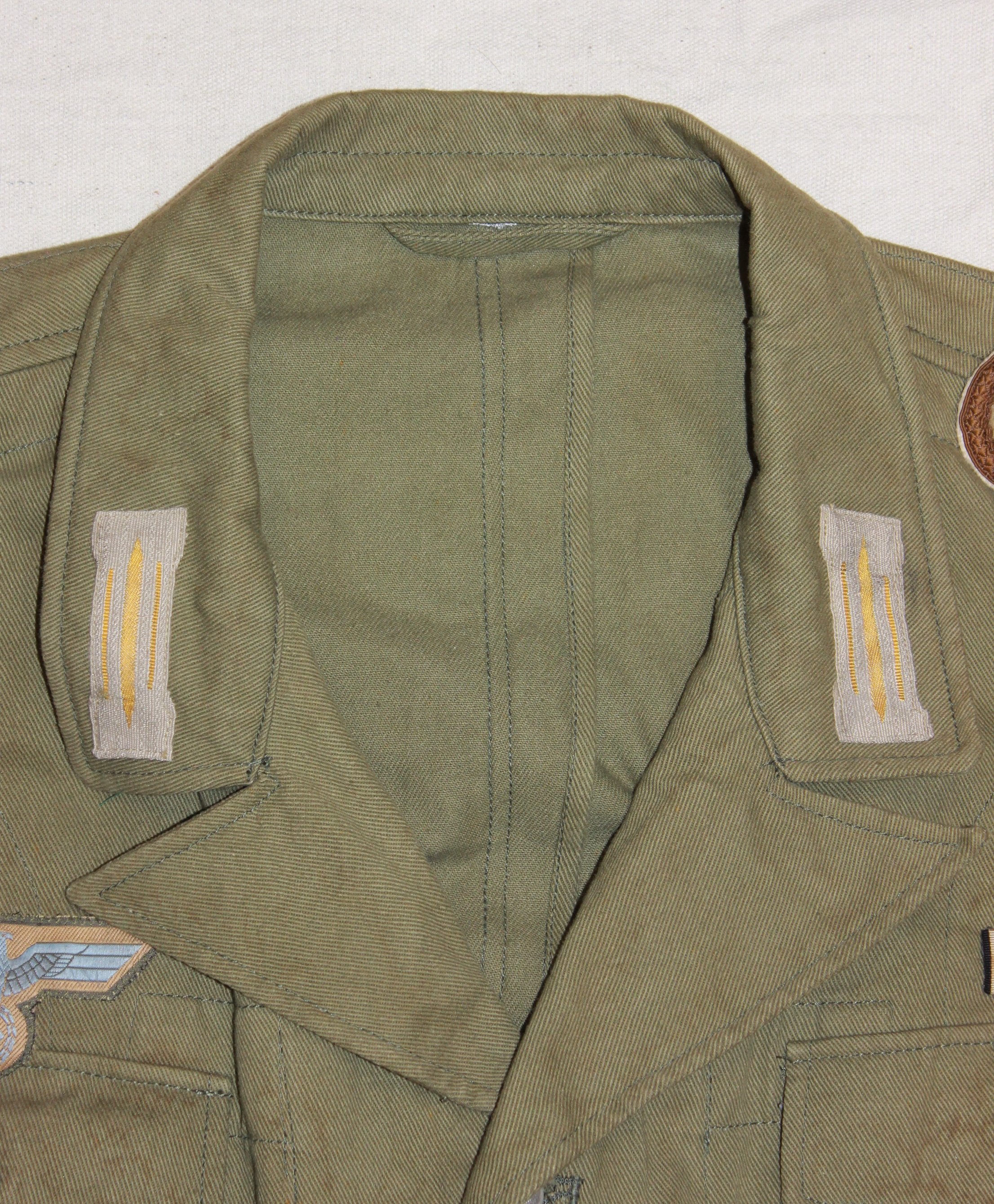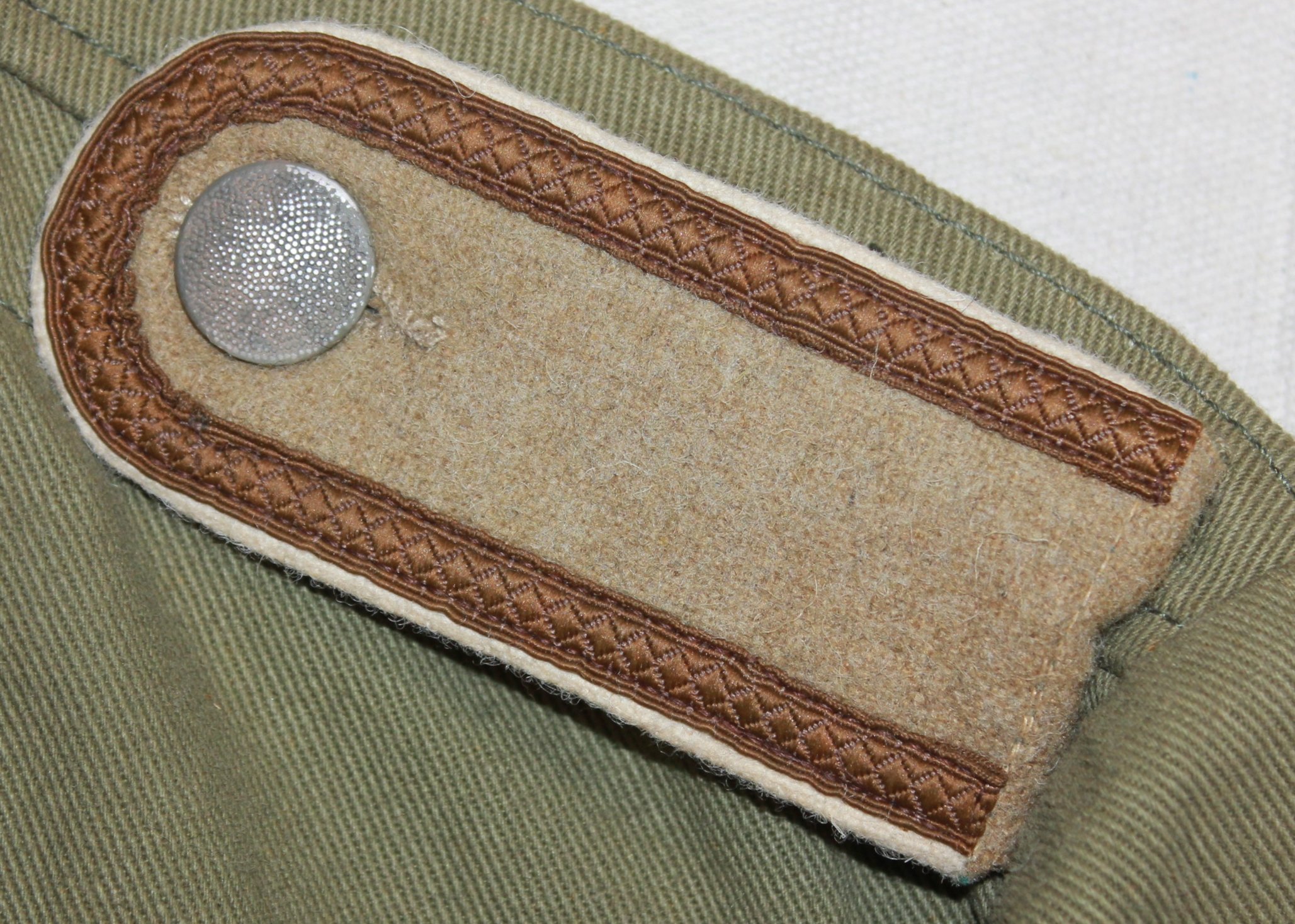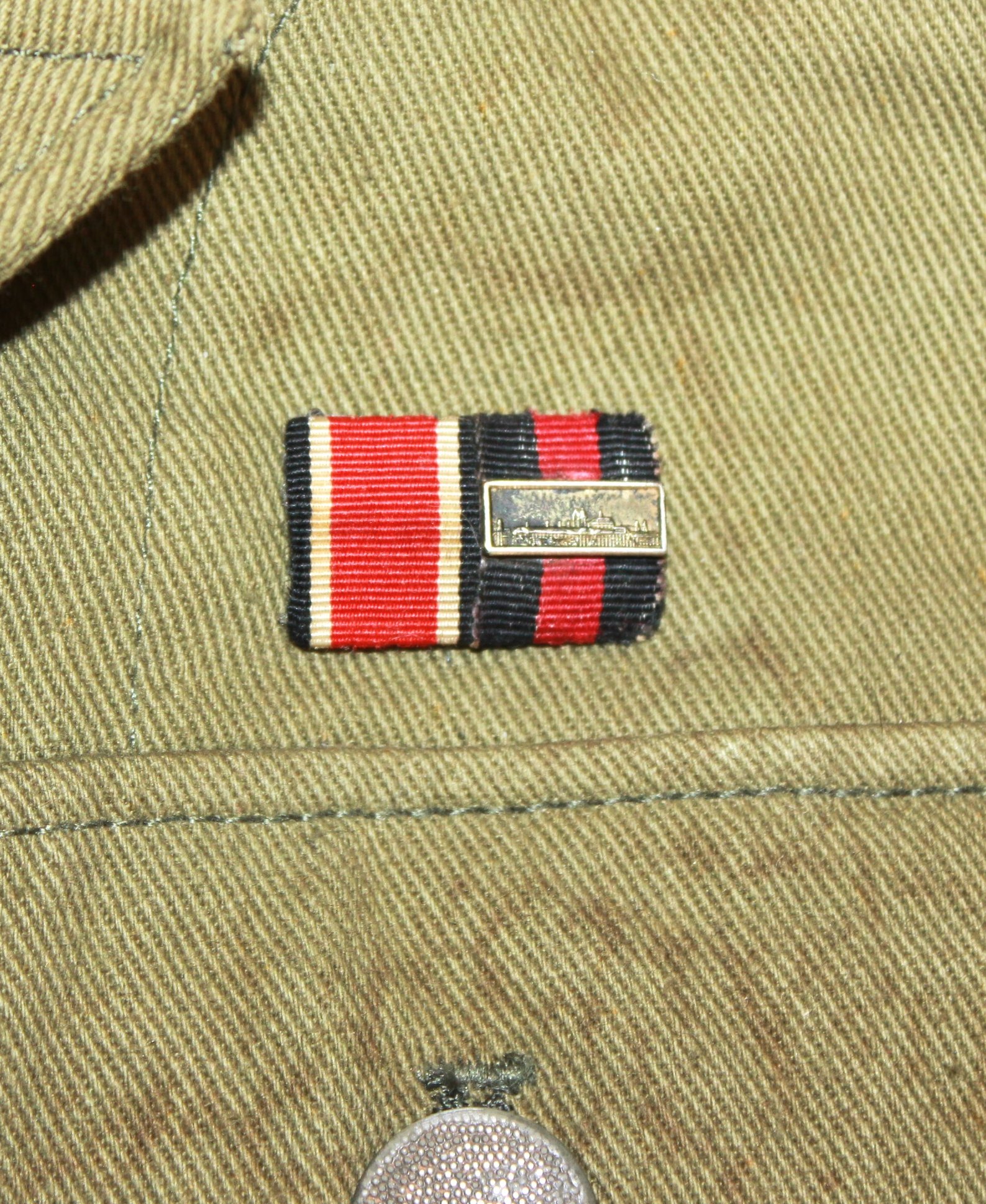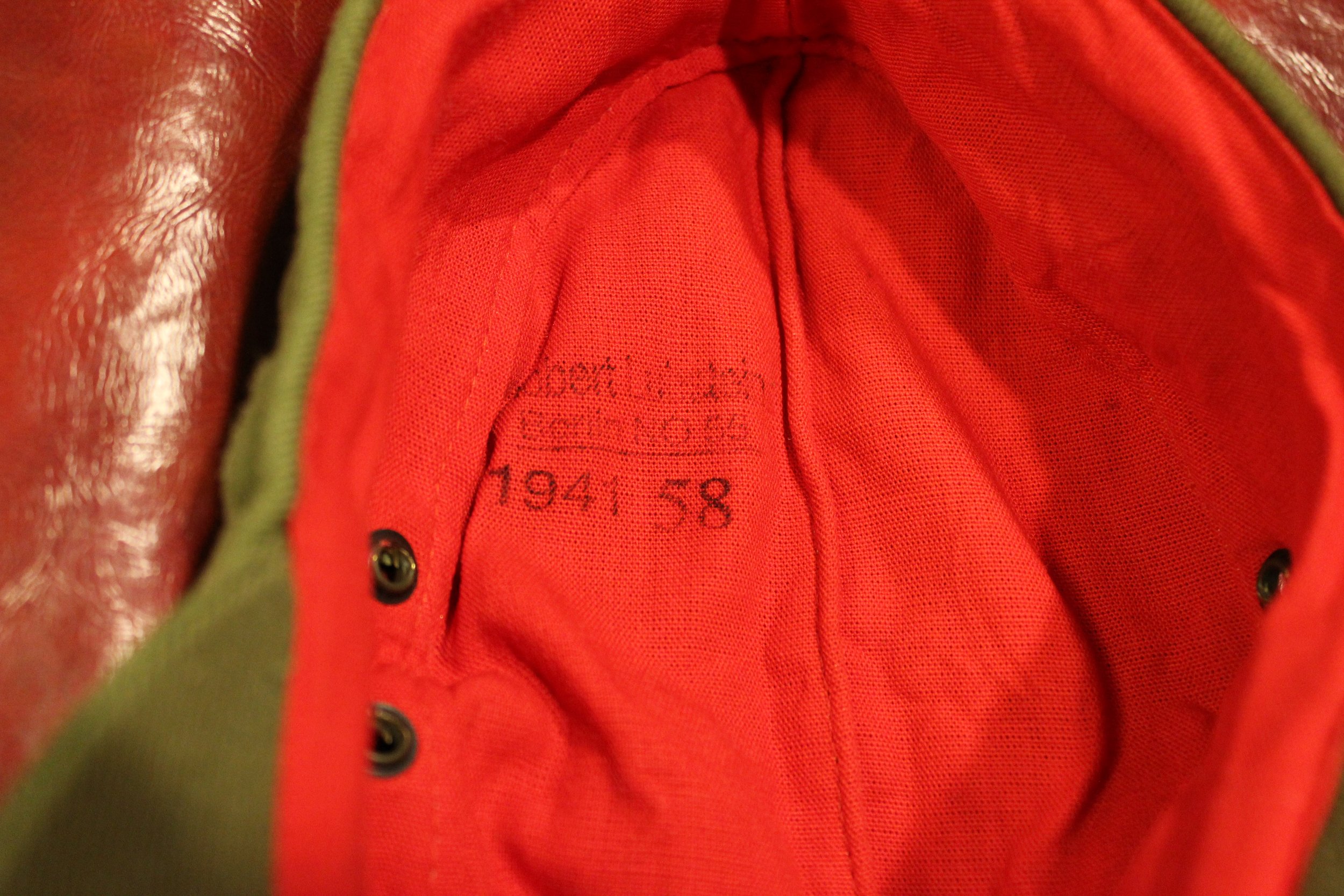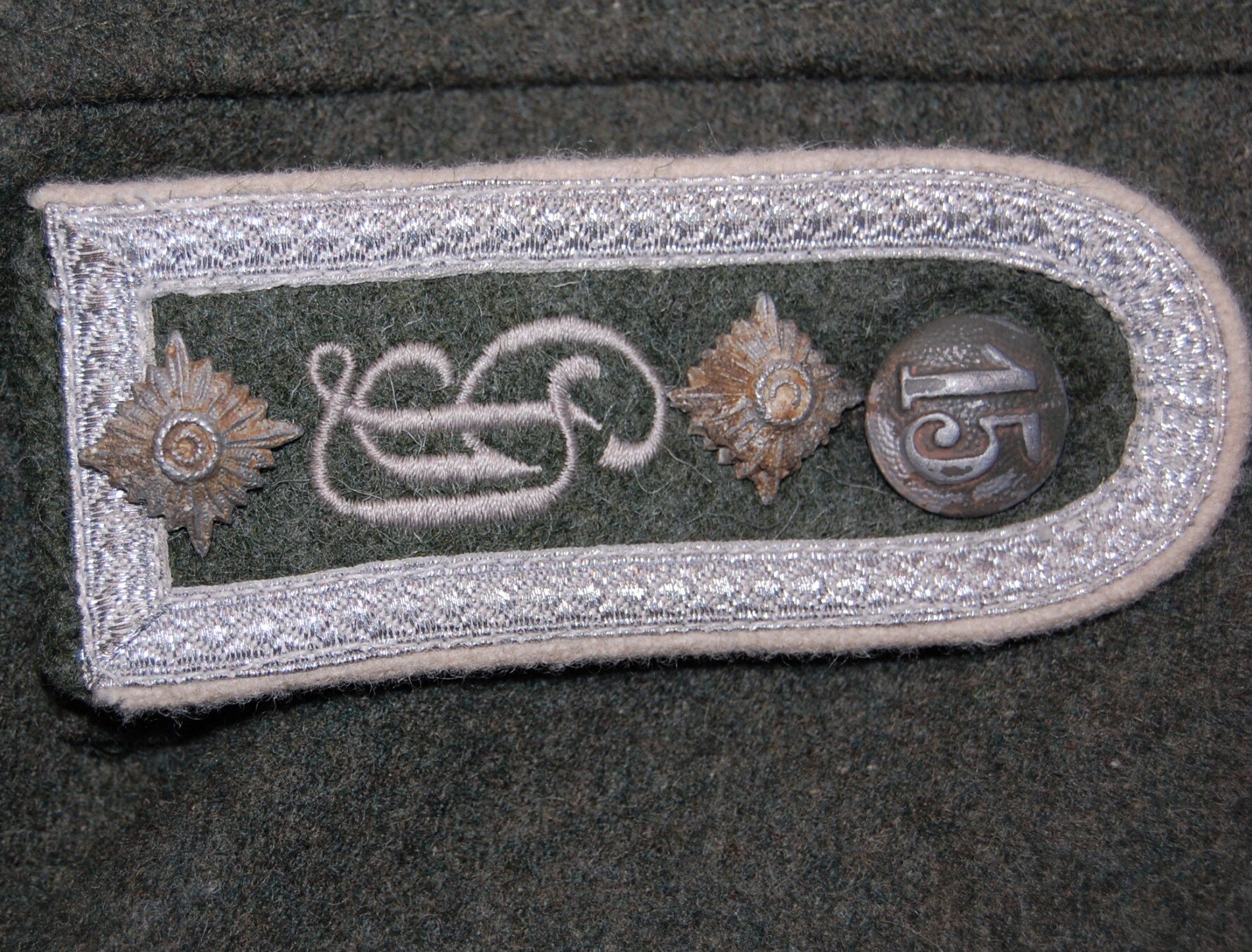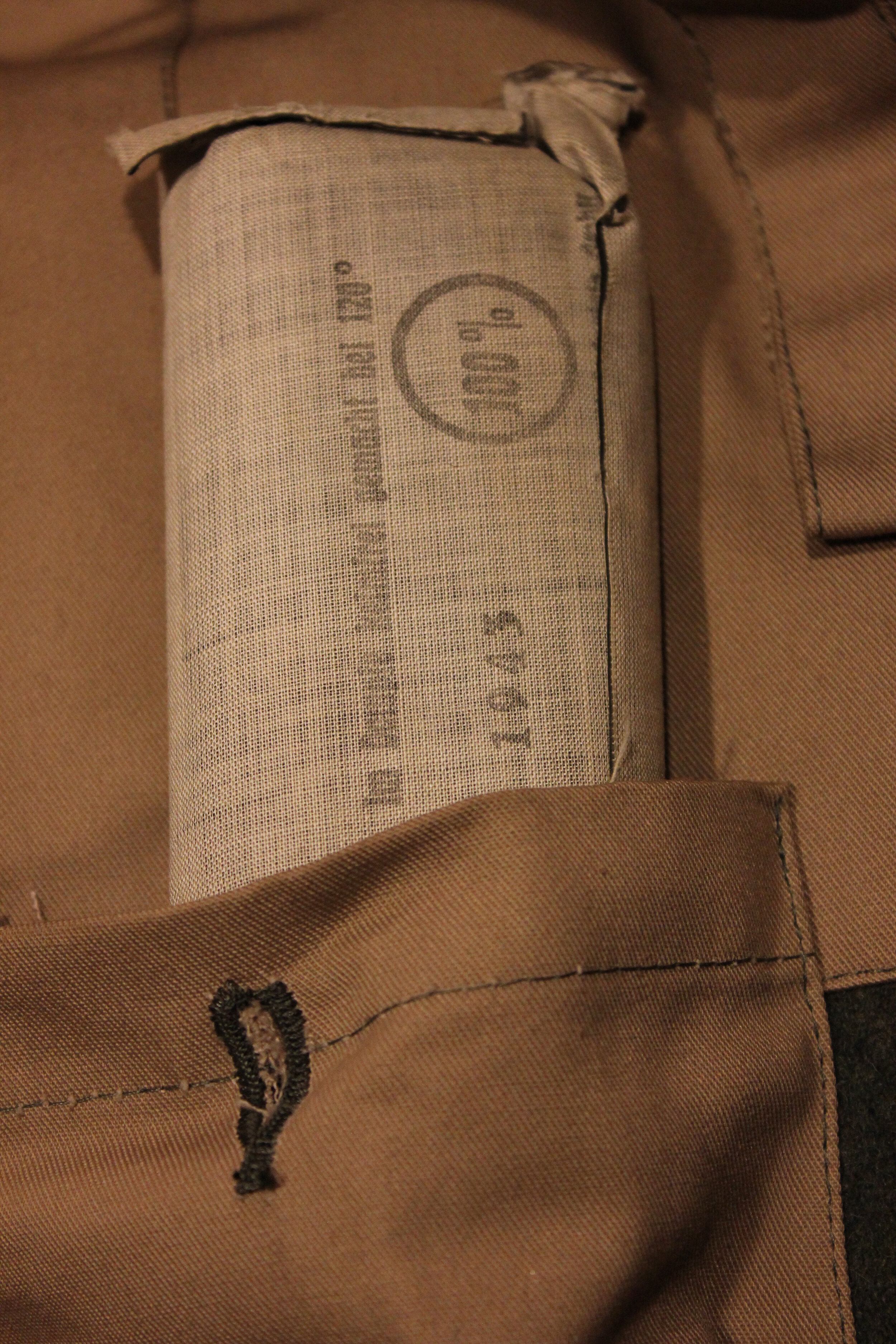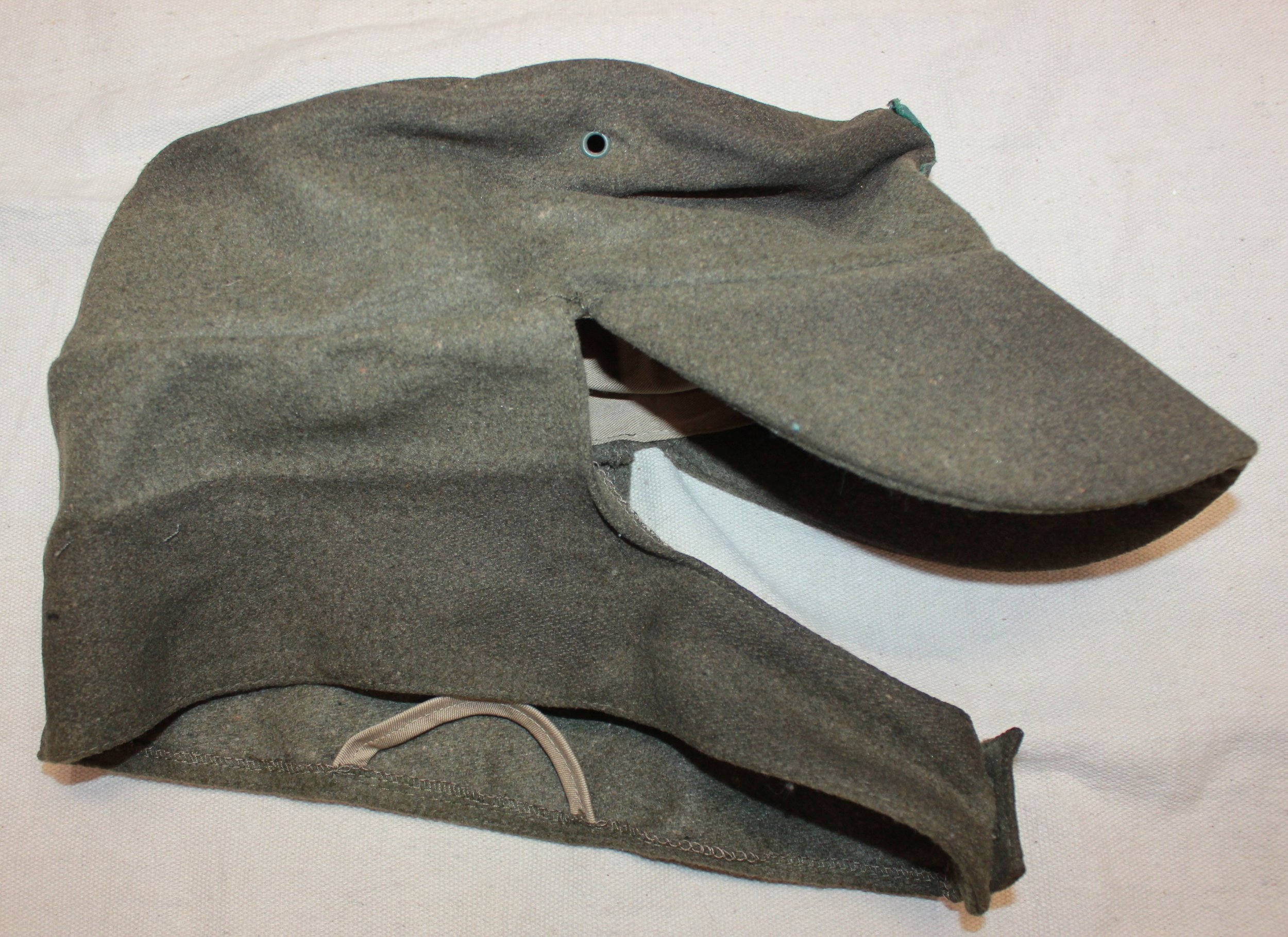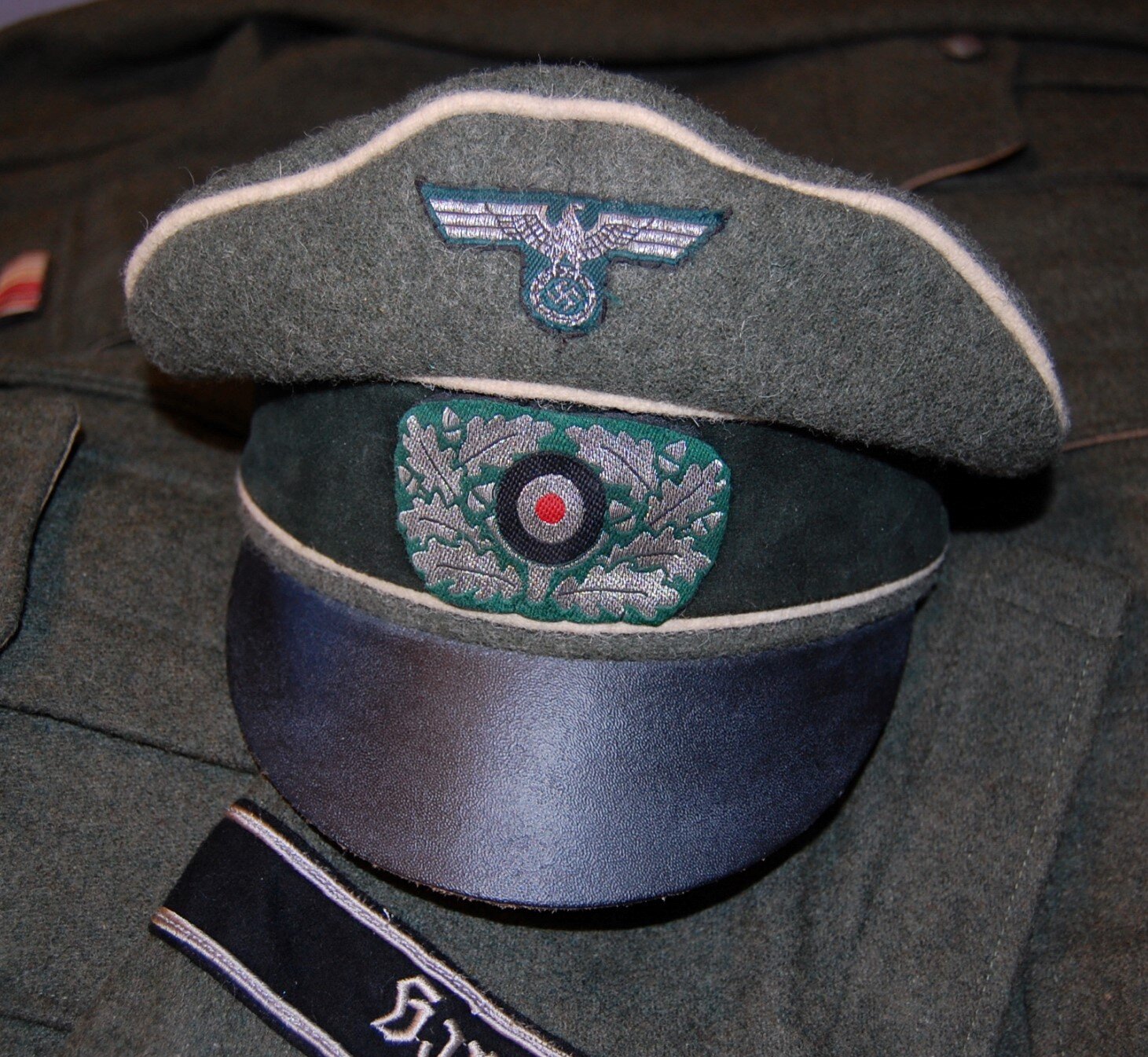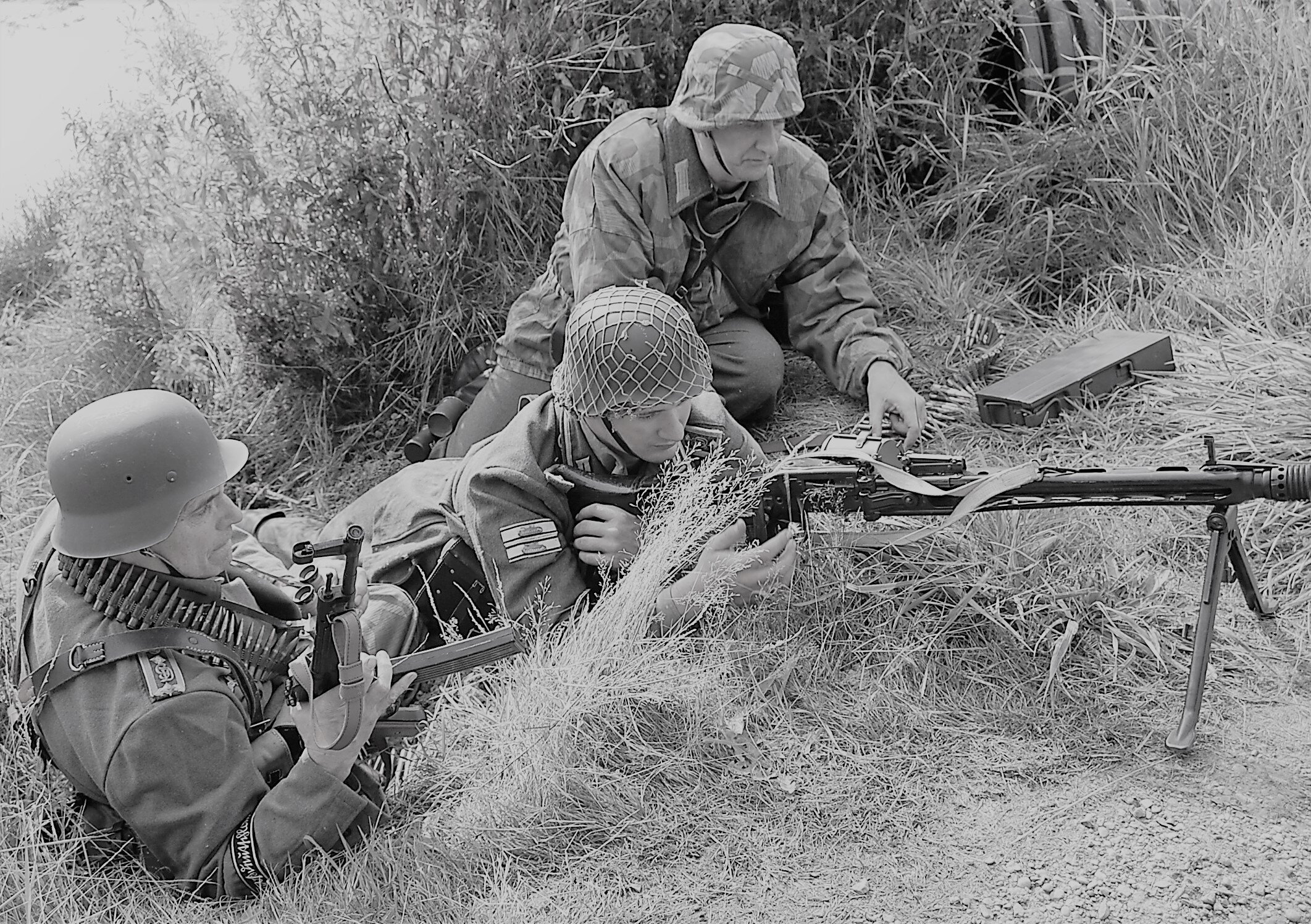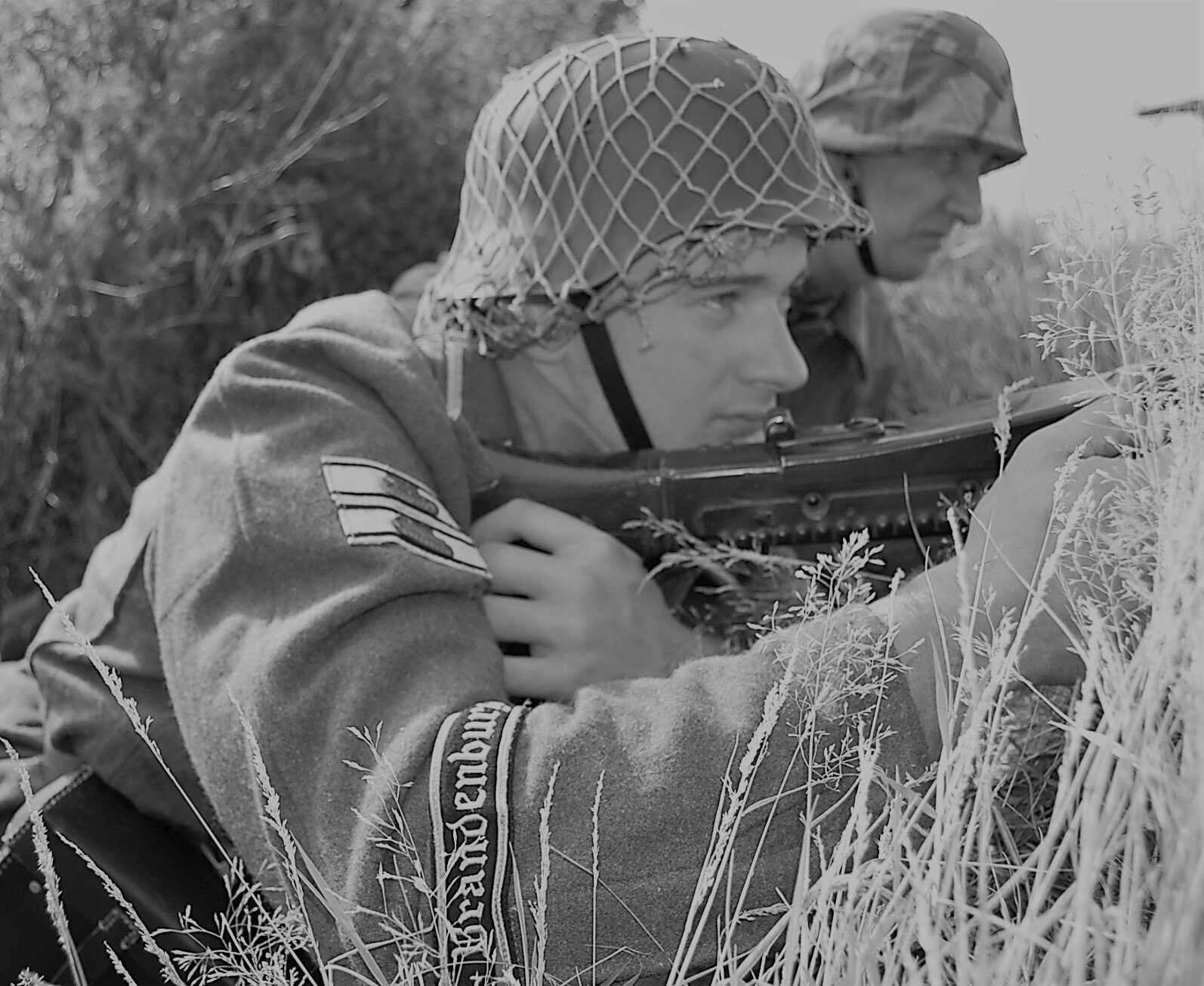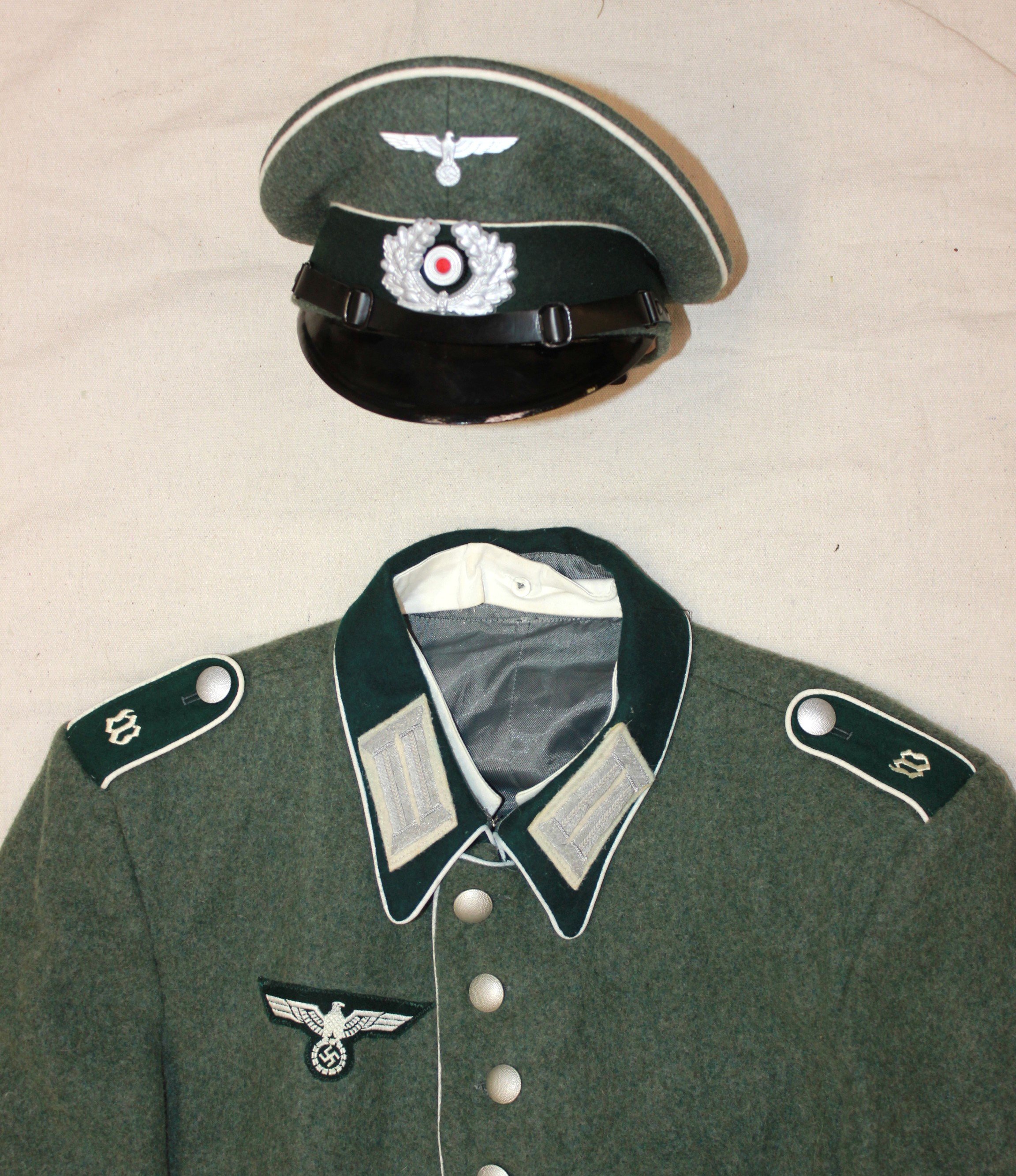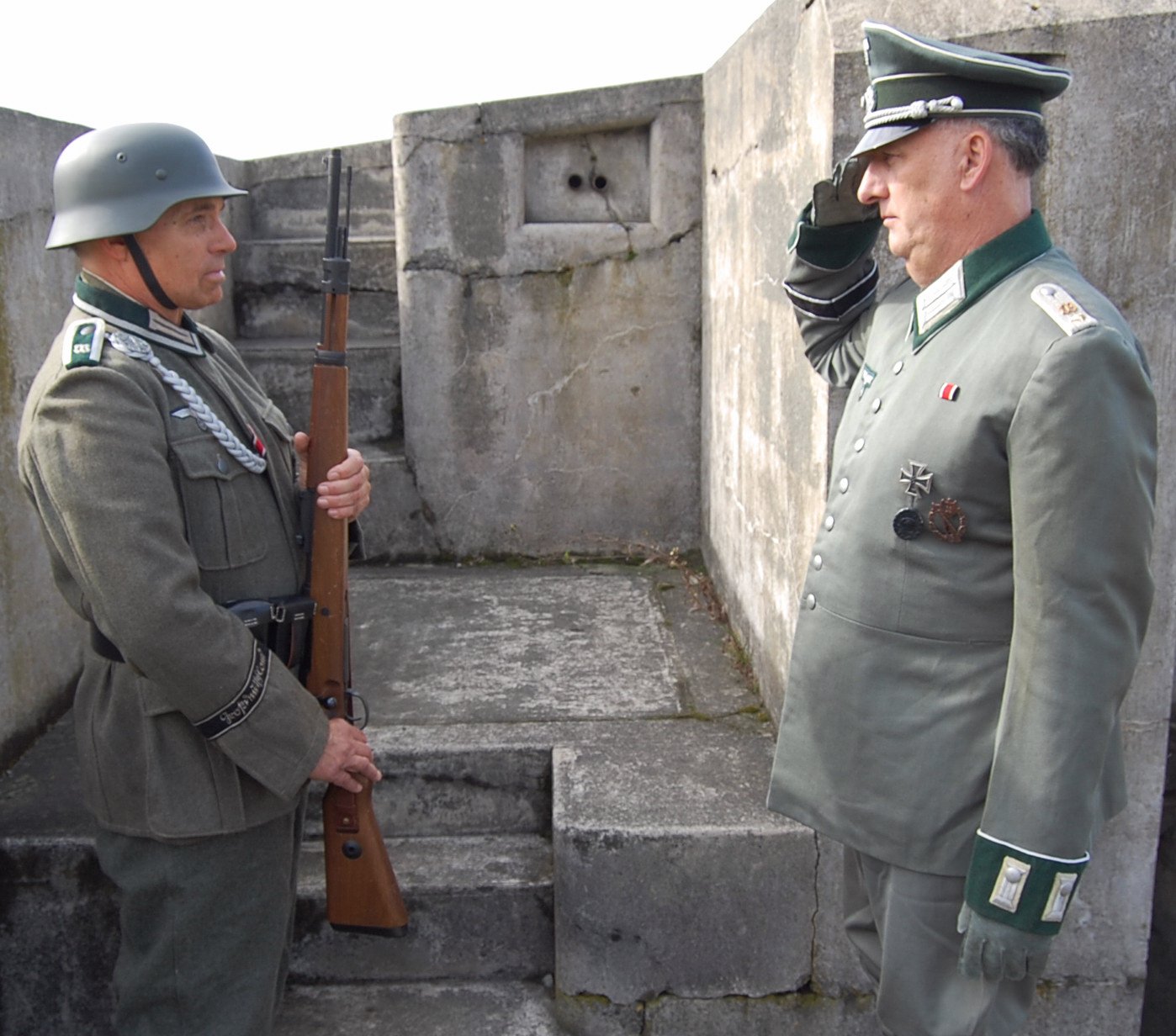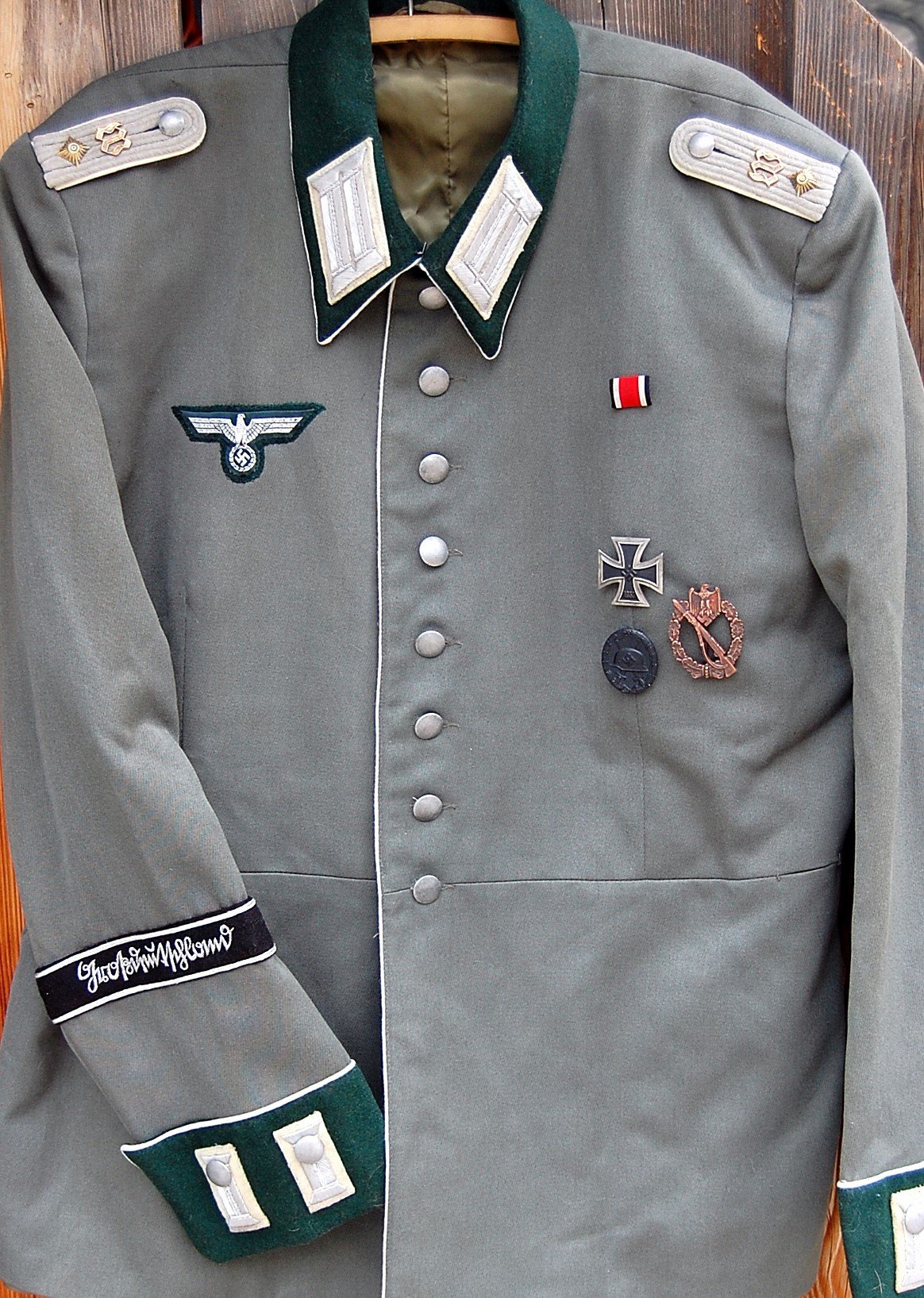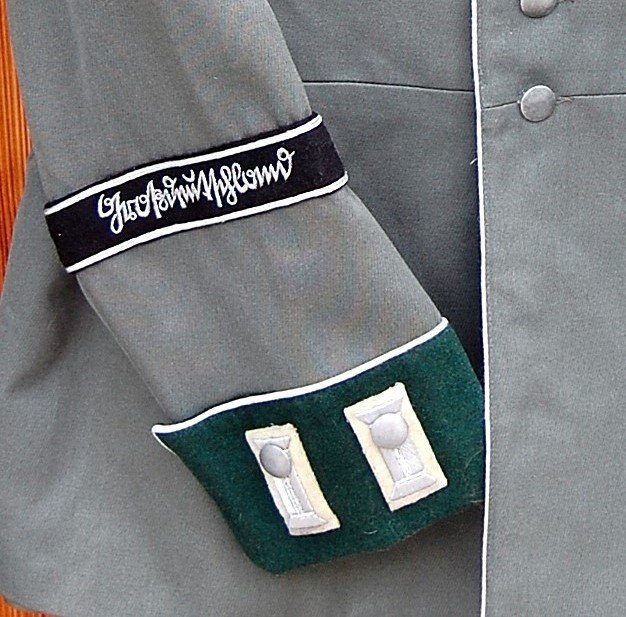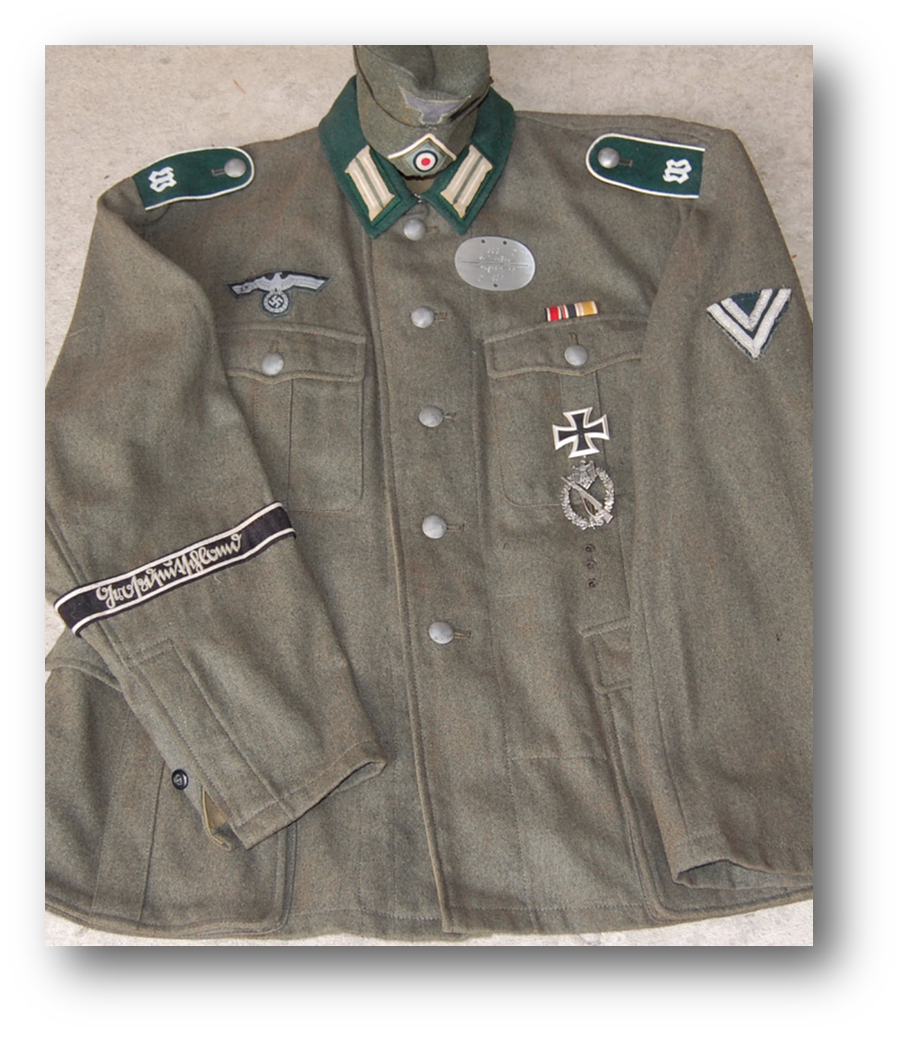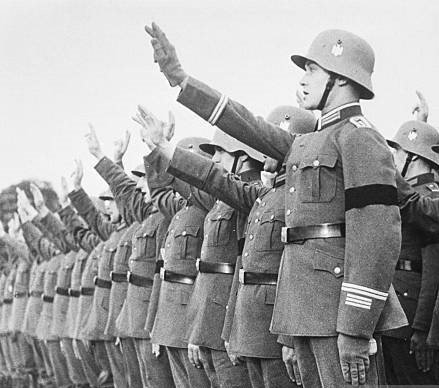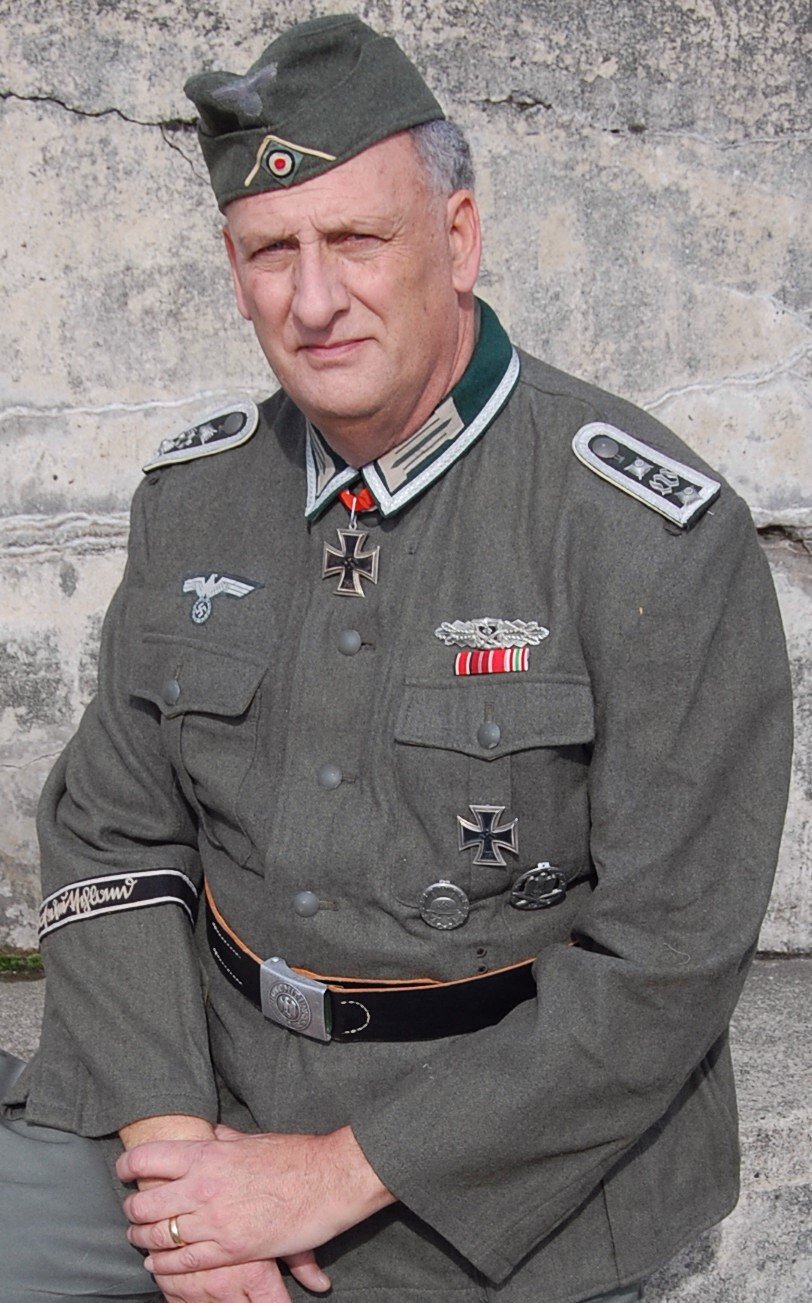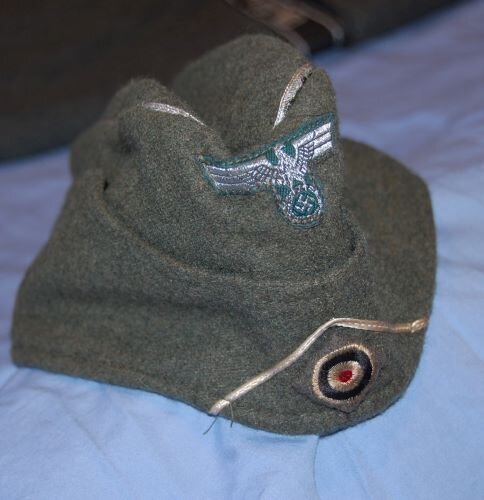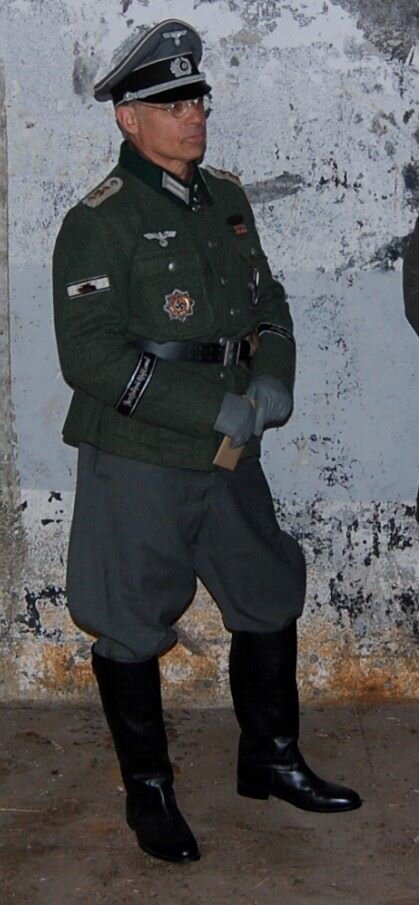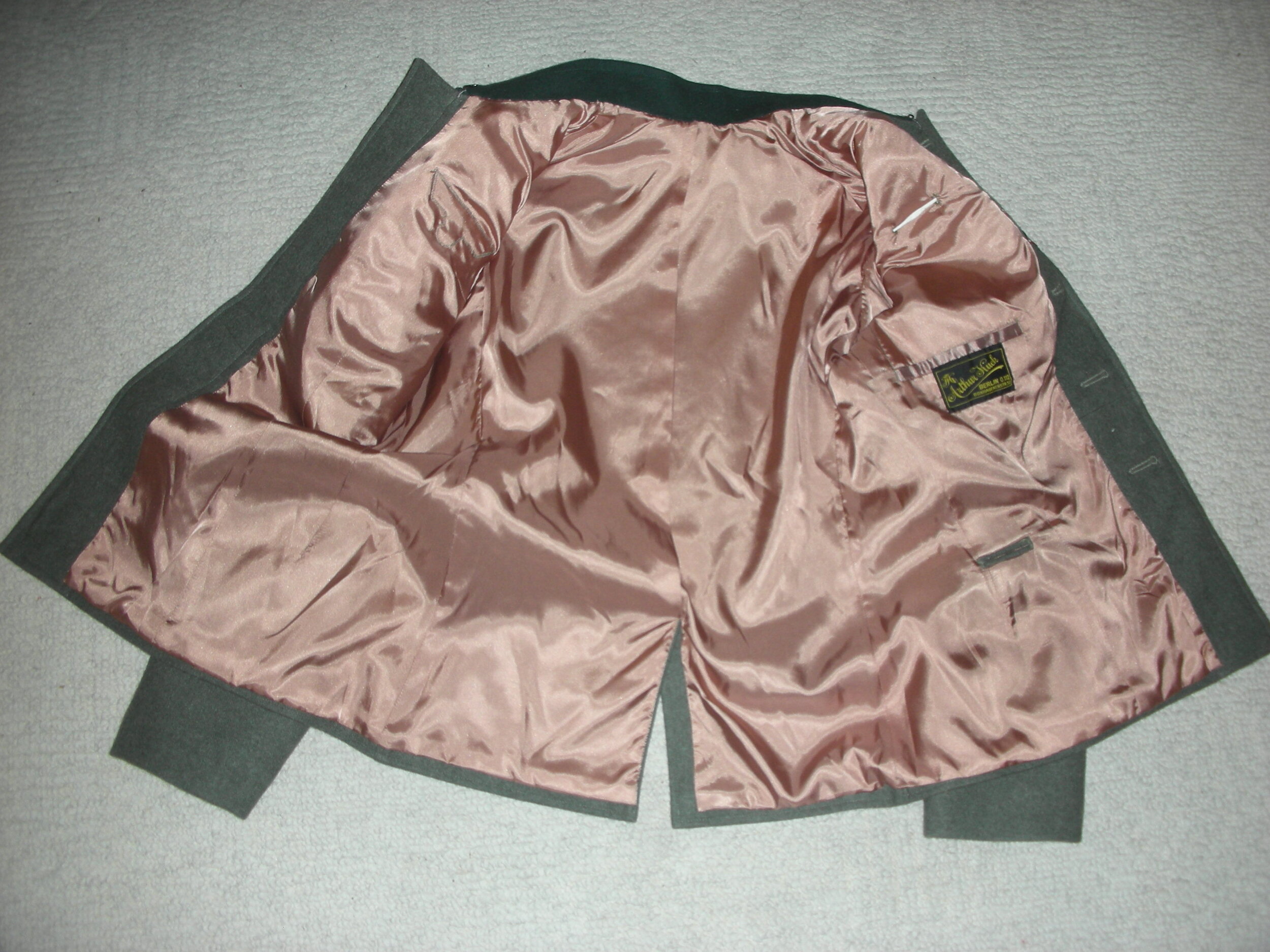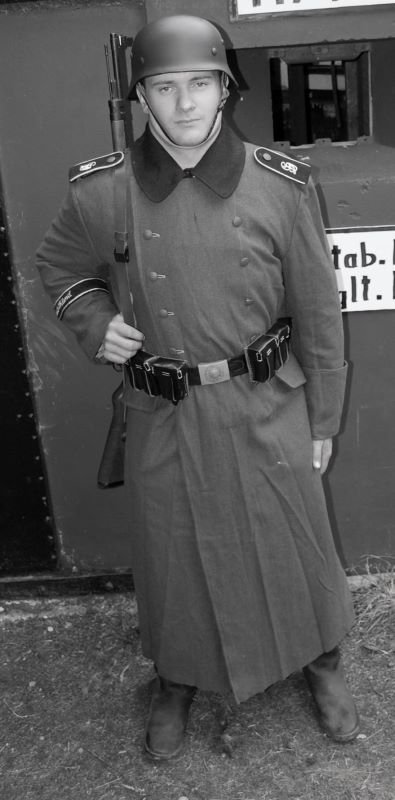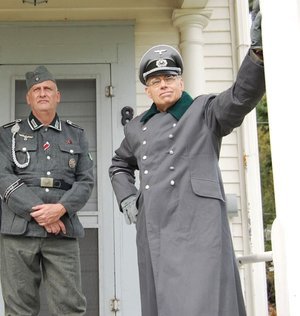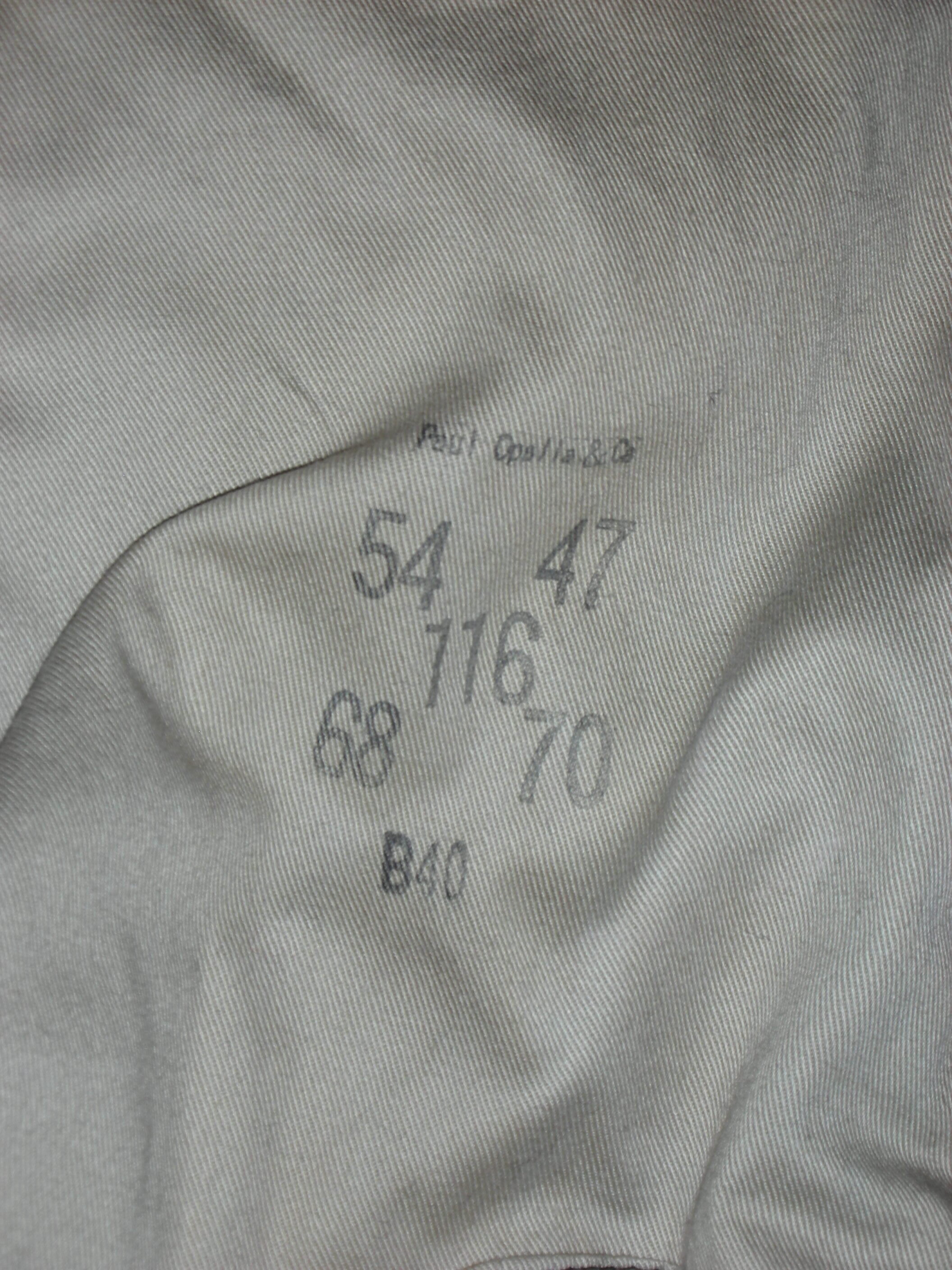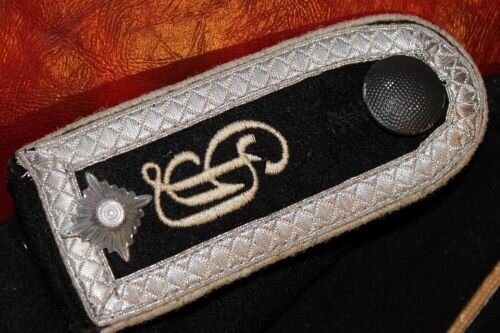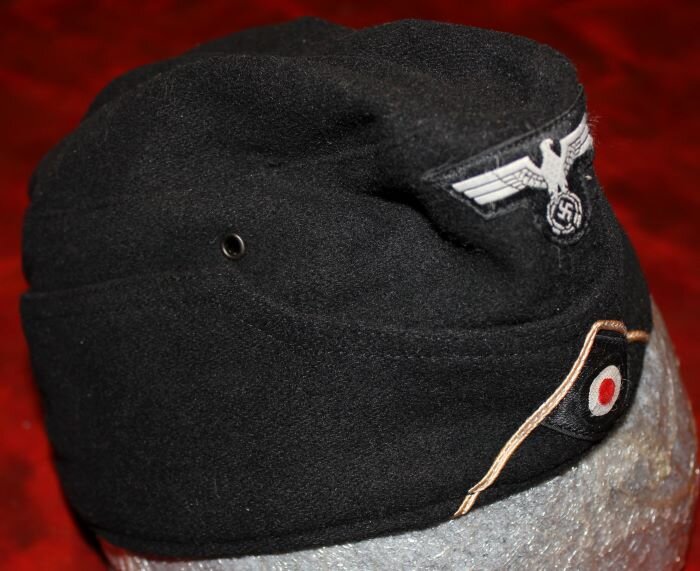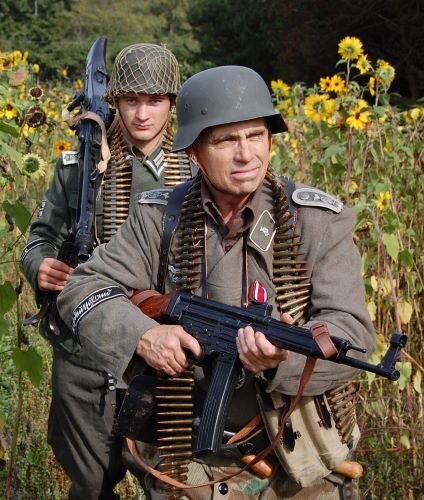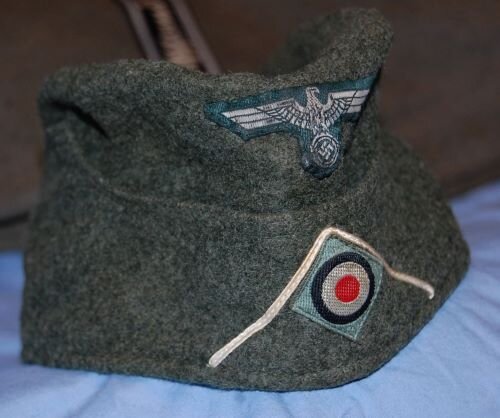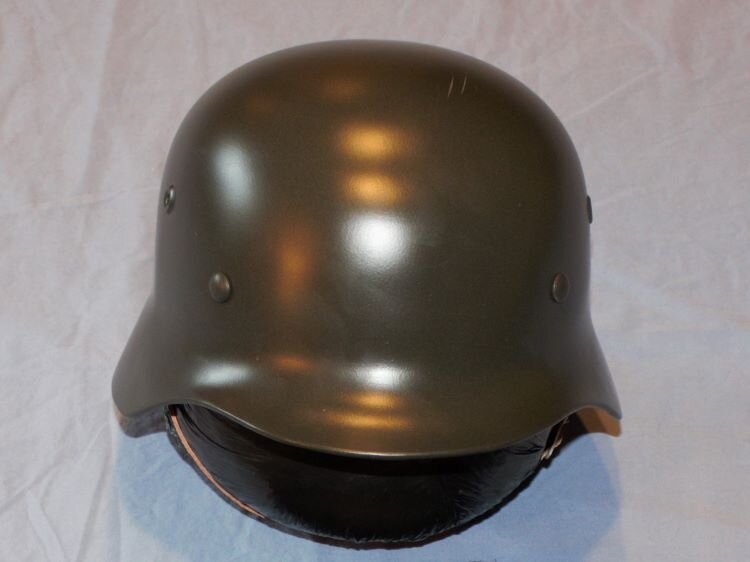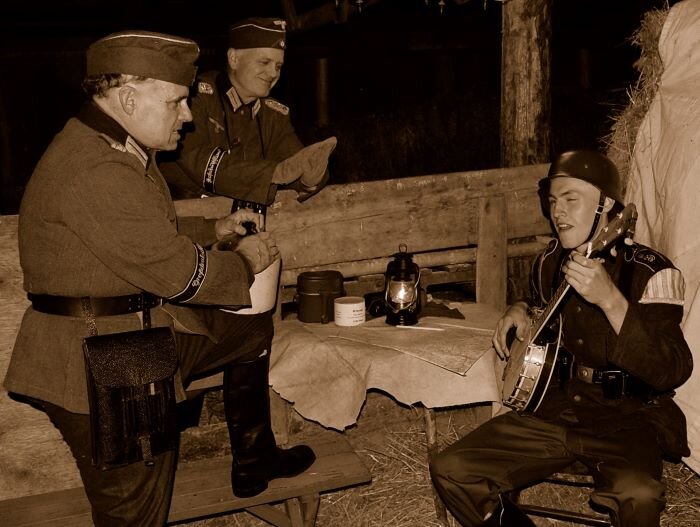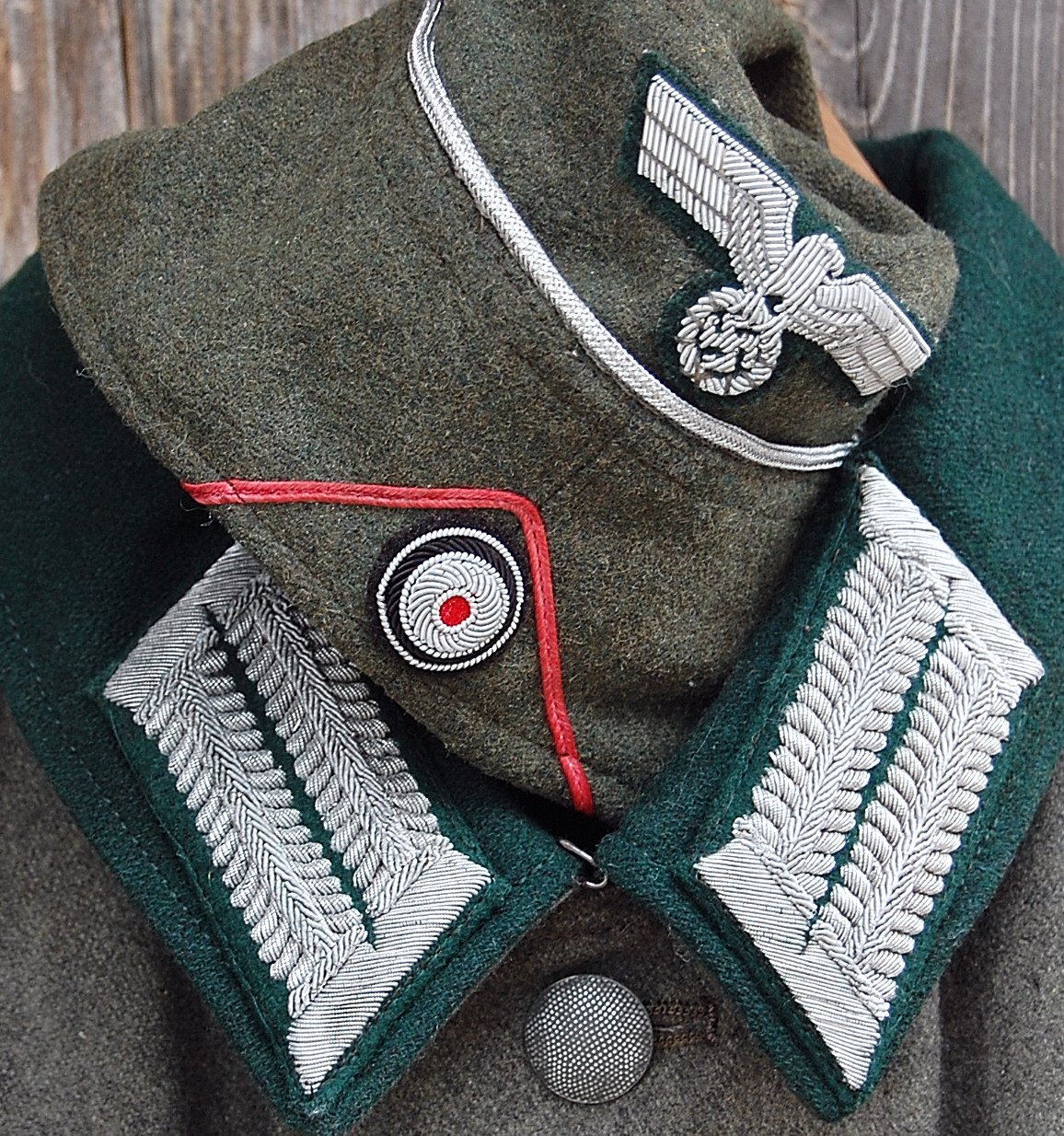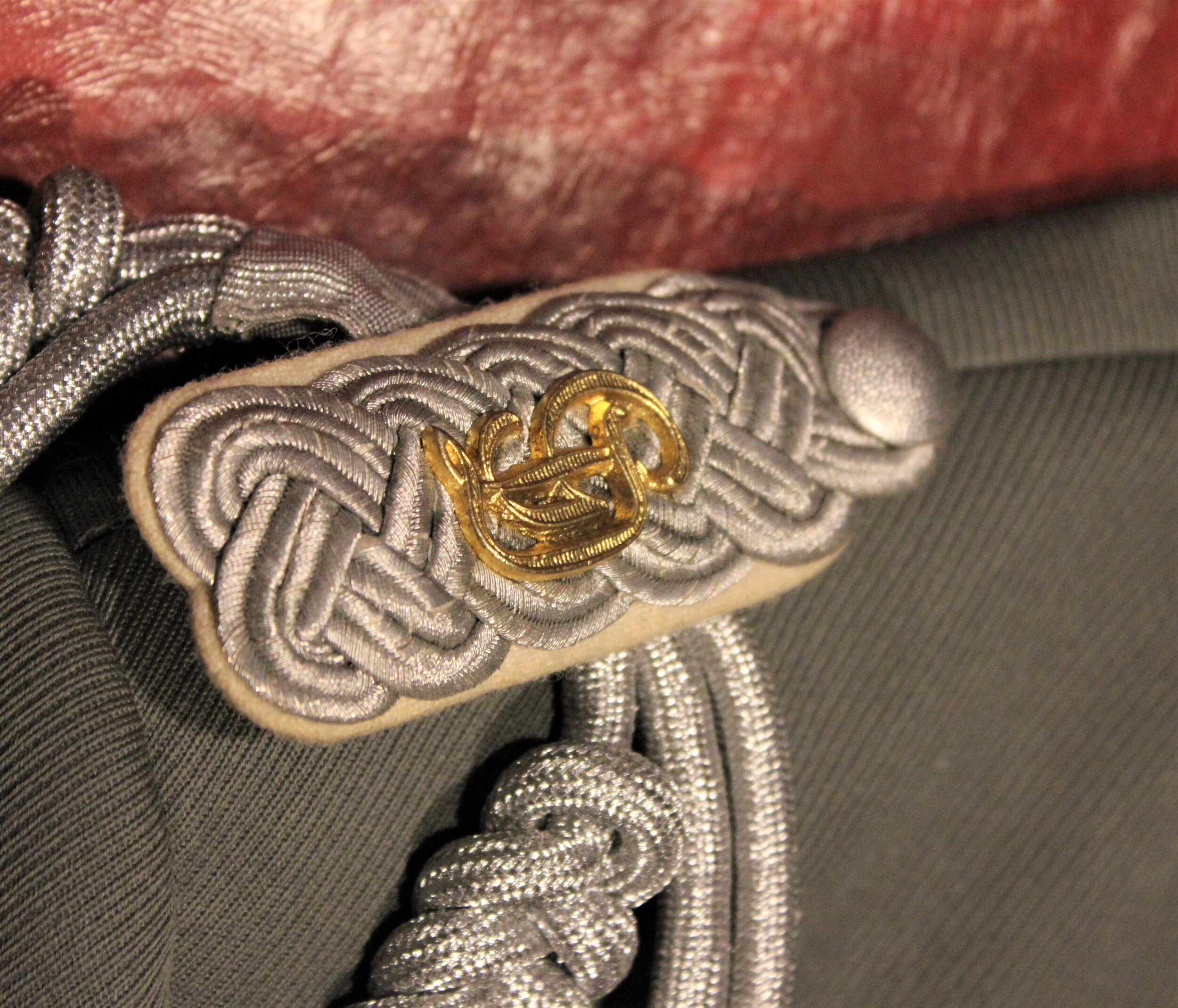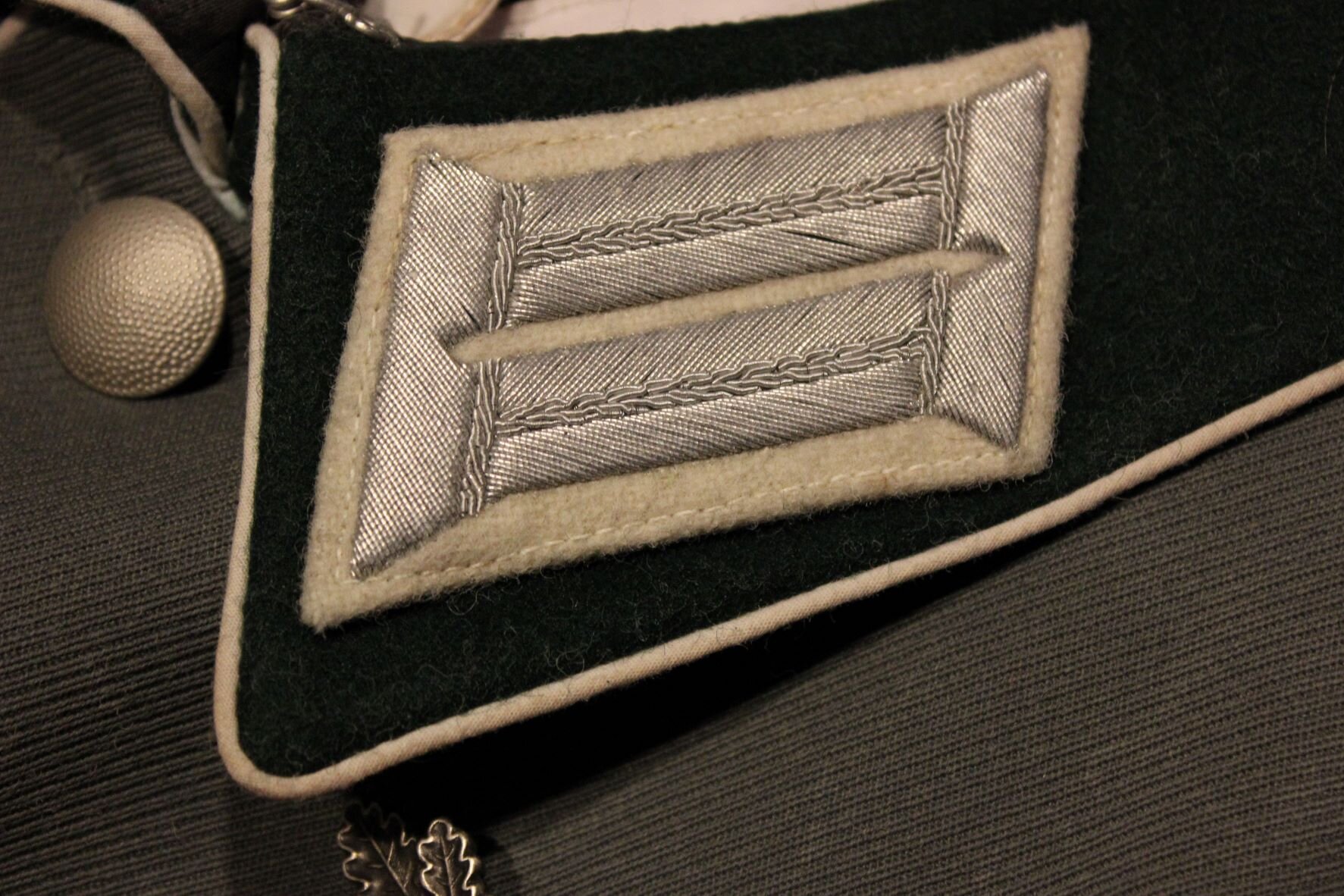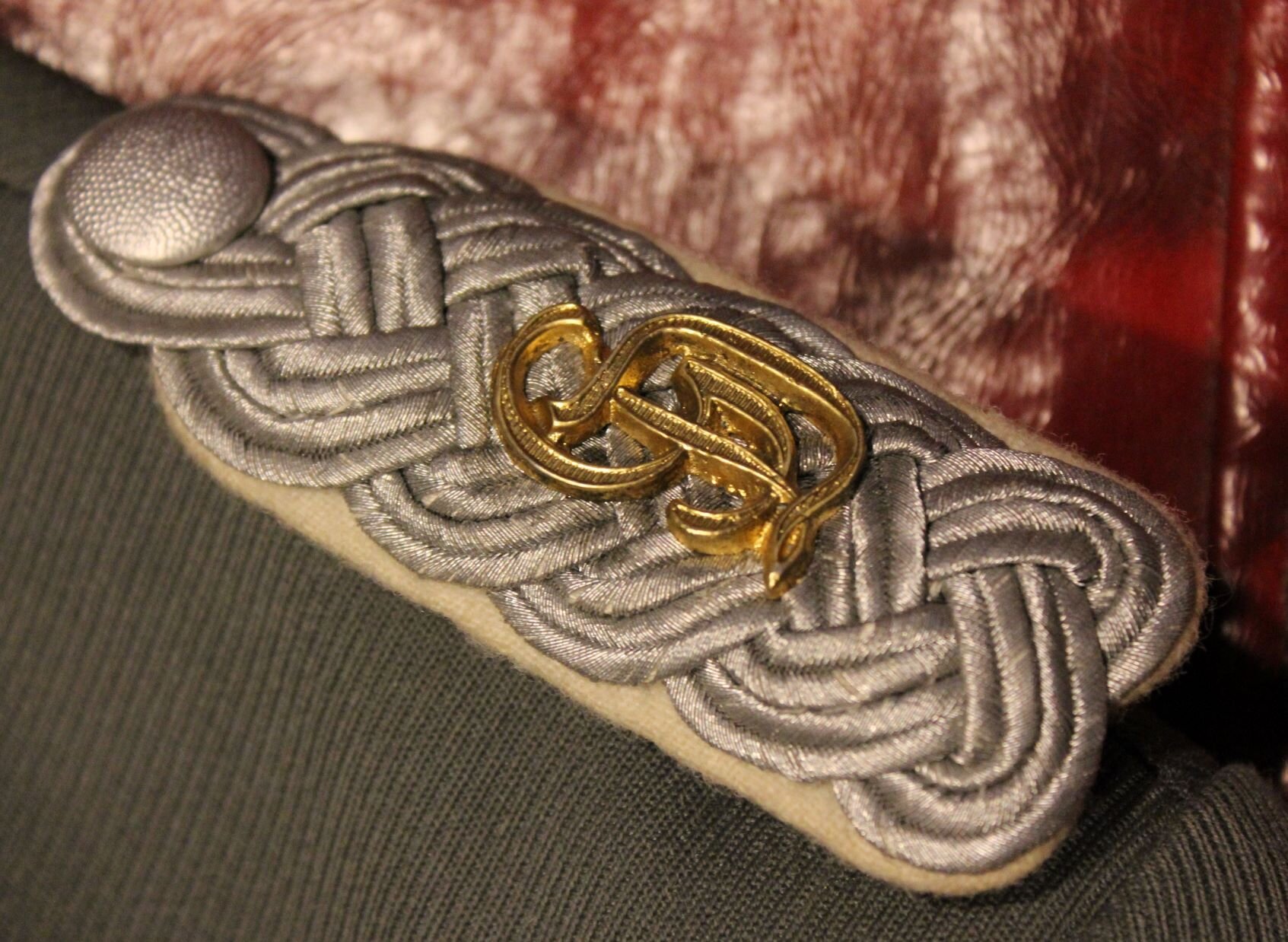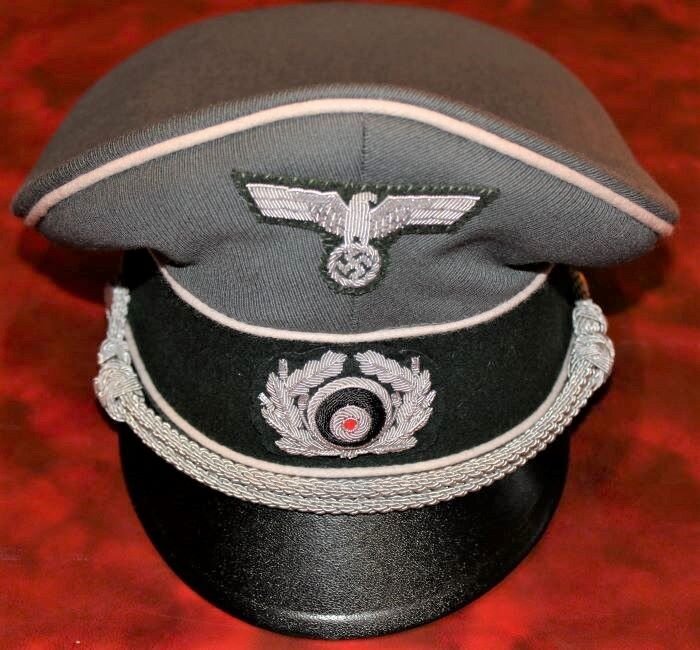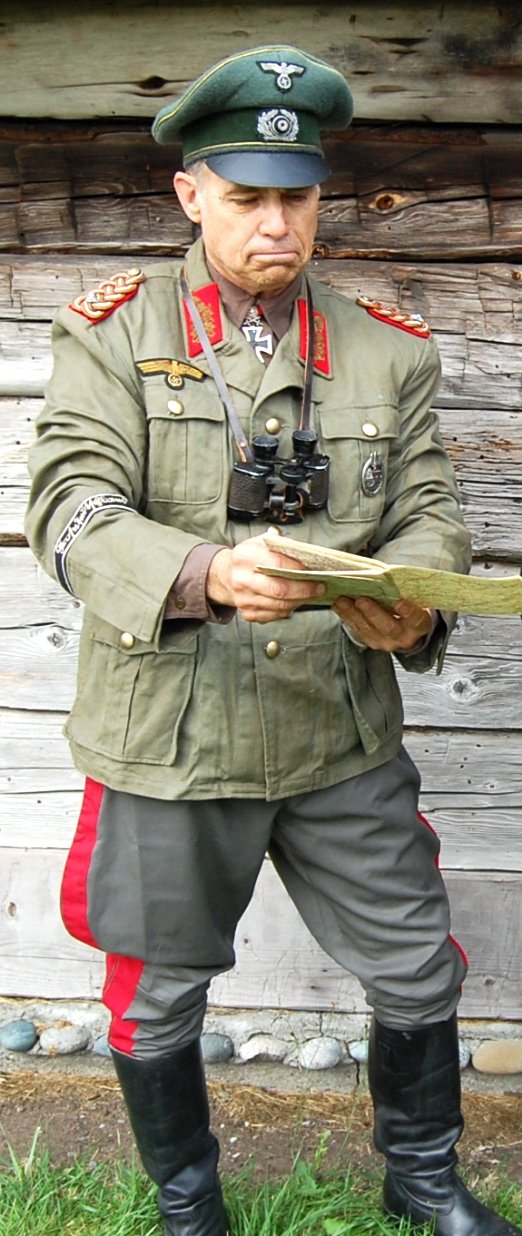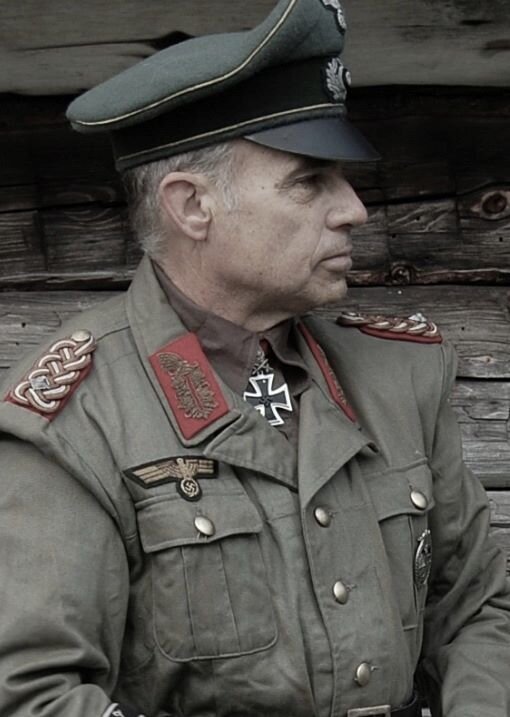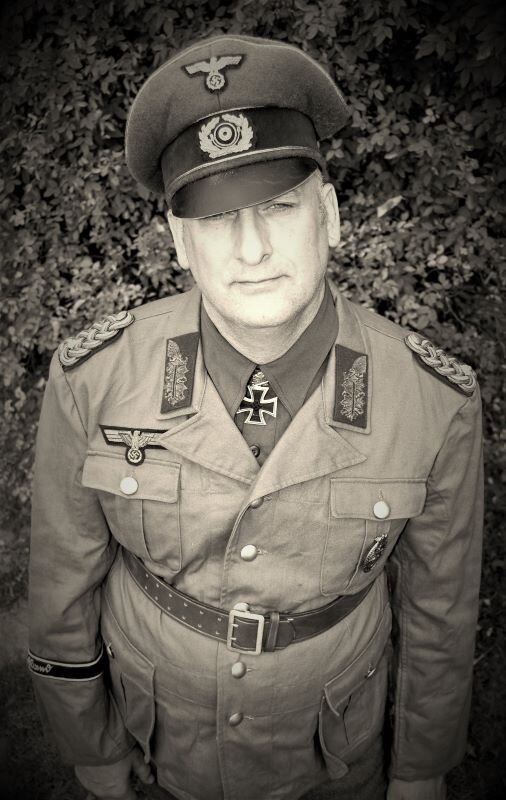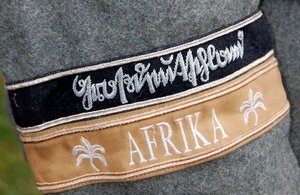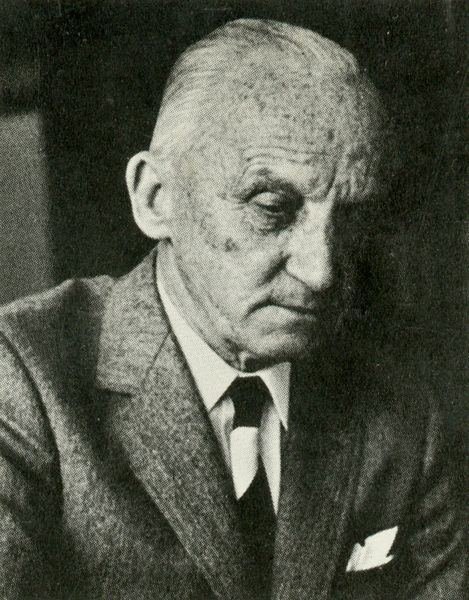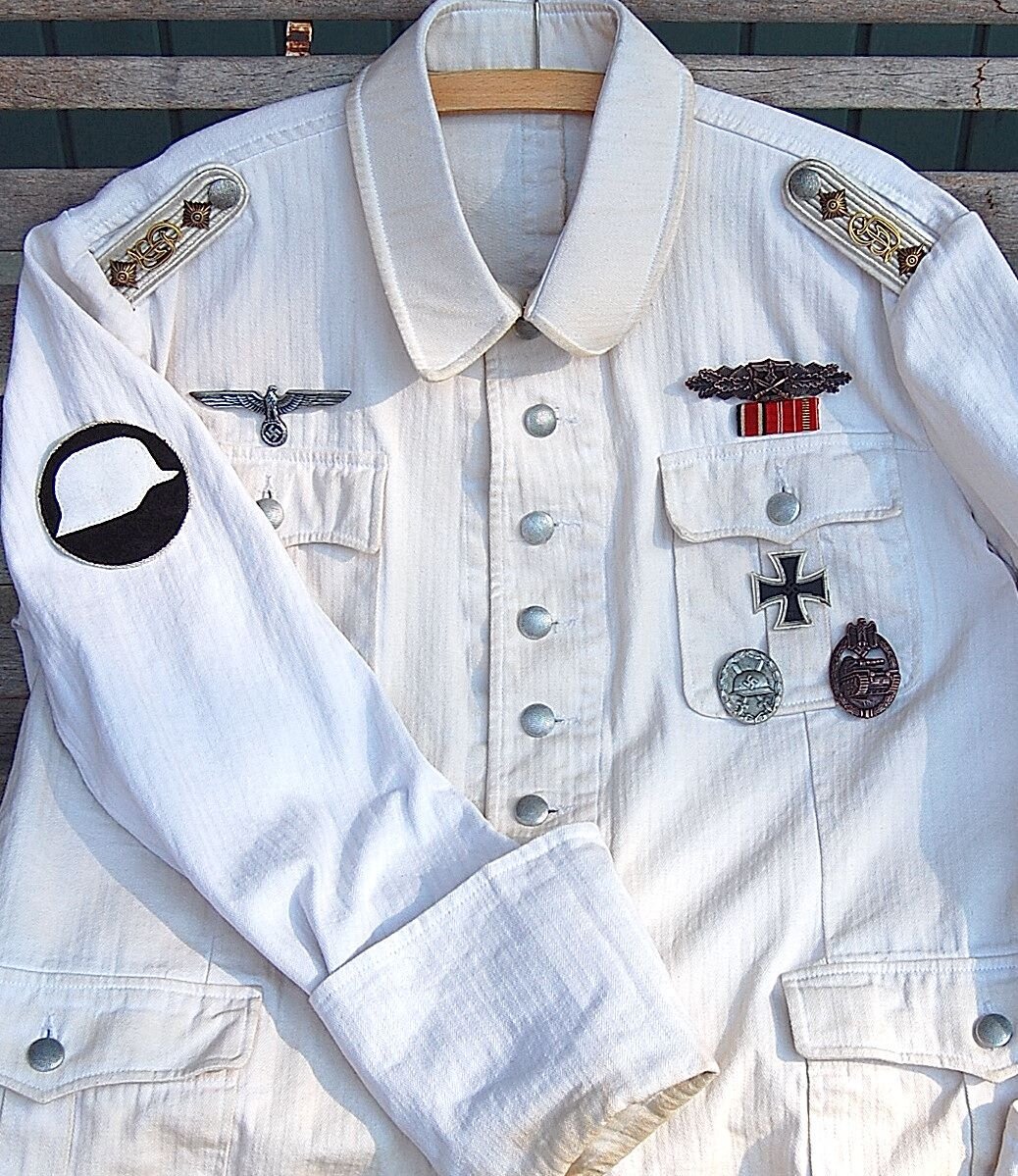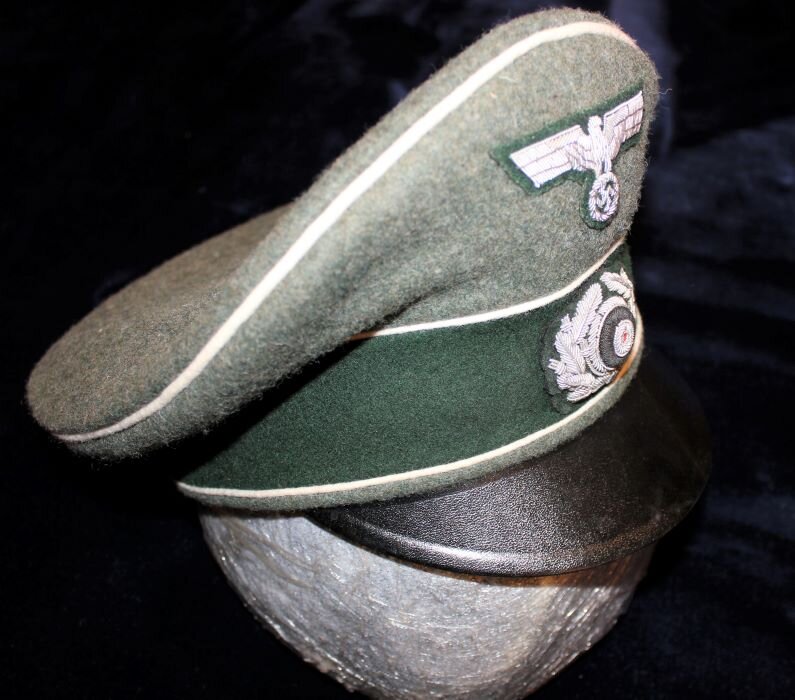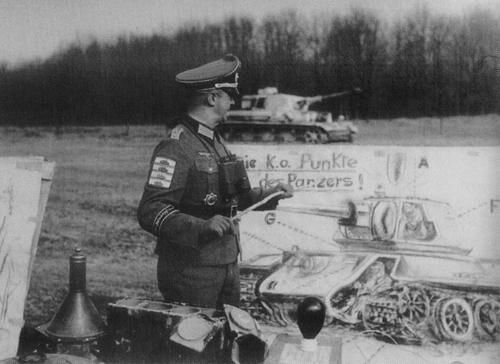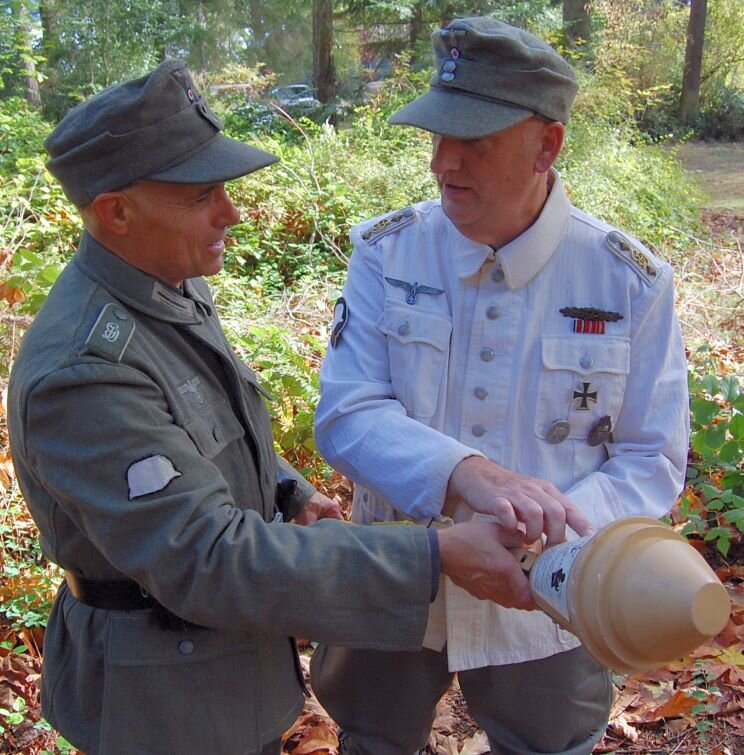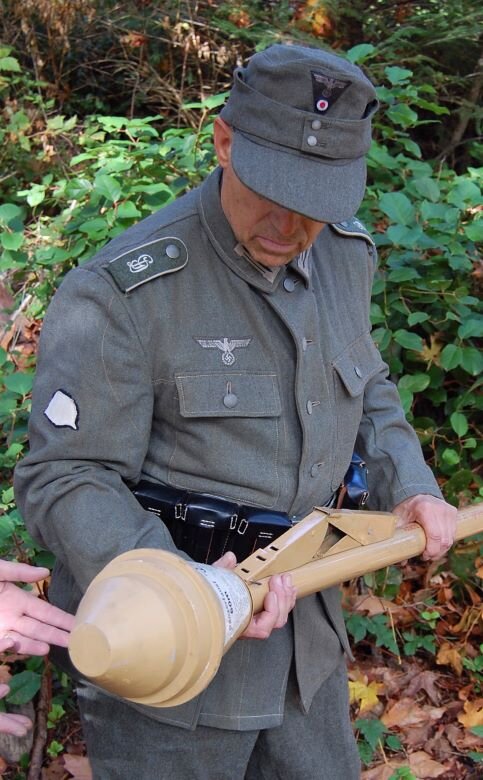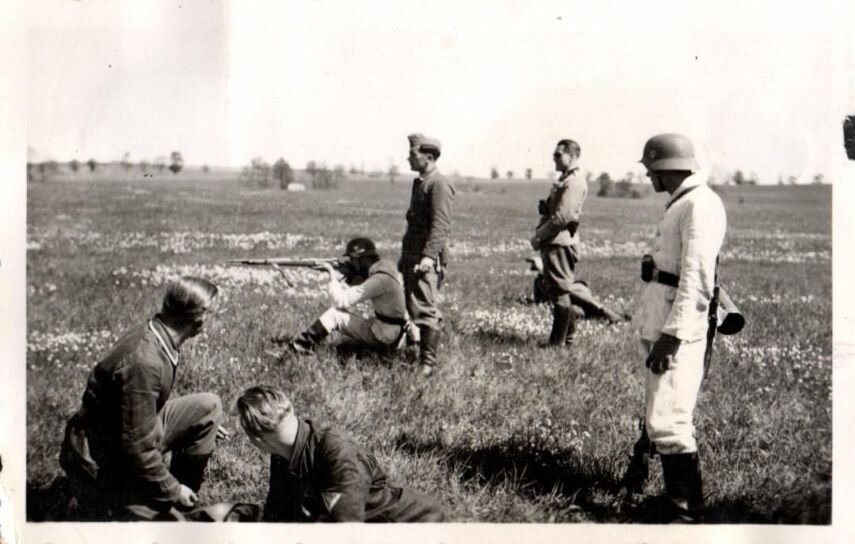Großdeutschland, The Fuhrer-Guard:
Unteroffizier, 4. /Kompanie, Sonderverband 288:
The Sonderverband 288 was raised on July 1st, 1941, at Potsdam (near Berlin). It was composed of units from all over Germany. Special Unit 288 (z.b..V.288) was known as Combat Group Menton, after its Commander.
It originally contained crack units from all branches of the German Military, Anti-Tank Men, Alpine Troops, Engineers, and eventually even 3 of the new StuG III Assault Gun Vehicles (Modified for tropical weather). There was also a Company of “Brandenberger’s” trained in infiltration, observation, and special operations behind enemy lines.
This Unteroffizier is from the 4. Kompanie was made up of soldiers who had trained as machine-gun teams and had been drawn from Infantry units. This soldier had participated in the occupation of Czechoslovakia before his assignment to the 288th.
His uniform is the standard “Heer'“ Tropical, with special theater-made shoulder boards. He has graduated from the early ‘Heer’ Parachute training at Stendal and has earned the Heer Fallschermjager badge (missing in photos of my uniform).
These units were intended to prepare the way for the DAK as it flowed across the Nile and into the Middle East and India. Their most important component was a group of interpreters with their printing presses! These men knew all the languages that would be needed, from Arabic and Persian dialects to Hindi, Urdu, and Sanskrit.
Part of the overall plan for German control of North Africa and beyond required the development of an Arab Force to fight against the British (UK) Force’s colonial rule. They helped form an “Arab Legion” to serve the purpose! There was also a specialized group that had been trained and planned on seizing and rebuilding the oil fields in the region.
When it became obvious that Rommel’s rush to the Nile…was not going to be a cake-walk, the 288th minus its interpreters and technicians was sent to Africa as special reinforcements.
They saw action during the Gazala Line Battles, and then the 288th saw action supporting the Italian Ariete against the French Forces defending Bir Hacheim at the southern tip of the British defenses. They also participated in the El Alamein Battles, and the last of their StuG IIIs was left behind for the British to contemplate. By October 31st, the Sonderverband 288 was reorganized and renamed the Panzer Grenadier Regiment Afrika.
He has the Infantry Assault Badge “from the first days of the war”, the EK-II, and the Sudetenland / Czech ribbon with the Prague bar on it. The German ‘HEER’ version of the Fallschiermjager ‘Wings and has the rare Sonderverband insignia on his Right sleeve (This insignia has been seen in the pictures of the StuGs the unit had received as well)is the only indicator of his special status, and most likely not standing out. The tunic is the standard tropical issue “Heer” tunic, it would have trousers and short boots, & ankle wraps, with the typical tropical kit. Helmet, with somewhat subdued insignia. Notice the M40 Army cap and Afrika-Korps cuff title, as he would have it in the theater.
Note the pictures are off the internet, so I can’t give credit to whom it’s due, the last 2 pictures show a Sonderverband / DAK member with the arm insignia, and also Totenkopf skulls on the lappels, indicating panzer crewmen, but this is unlikely the case and there is more to this story, although, the unit is reported to have used a couple of StuG assault vehicles, this is not a sure thing.
“UPGRADED” Hauptfeldwebel, Panzergrenadier Division “Brandenburg”:
The Brandenburgers were members of the German Special Forces unit during WWII. There are not many pictures of these soldiers in action, as they operated at times in civilian clothing, and did not want people filming and recording the actions they were on at any given time. Units of Brandenburg operated on all fronts throughout the war in some form or another.
They were in on the Invasion of Poland, Denmark, and Norway, the Battle of France, Operation Barbarossa, Finland, and Greece, and they were involved in the Invasion of Crete, Romania, Bulgaria, and Yugoslavia. Some units were sent to infiltrate India, Afghanistan, Middle Eastern countries, and South Africa. They also trained for Operation Felix (the planned invasion of Gibraltar), as well as Operation Sea-Lion (the planned invasion of England).
The unit had stunning success early in the war, operating in advance of the Regular Army, capturing strategic bridges, roadblocks, and tunnels, and securing rail yards in Poland and the Netherlands.
The unit was the brainchild of Hauptmann (Captain) Theodor von Hippel, who, after having his idea rejected by the traditionalist Reichswehr, approached Admiral Wilhelm Canaris, commander of the German Intelligence Service of the Abwehr, where he got a very different result.
Regiment Brandenburg evolved out of the Abwehr’s 2nd Department and was used as a commando-type unit during the first years of the war. Initially, the unit was full of a bunch of former German expatriates fluent in other languages, and many special clandestine talents. Until 1944, it was an OKH unit rather than a unit of the Regular Army (Heer) part of the Wehrmacht. But the unit continued to expand, growing steadily, and it was decided to relocate them into the Grossdeutschland Panzer Korps, a special outfit in itself, they were attached to the frontline combat unit.
In mid-1943, King Victor Emmanuel III of Italy ousted the Fascist Dictatorship of Benito Mussolini and changed sides. Following this, many Brandenburg units were moved from the Balkans and took actions to disarm the Italian soldiers and secure the areas the Germans would need to secure the region’s vital areas for the German War Effort.
One vital area was the island of Kos, in the Dodecanese island chain off the north coast of Turkey. Kos had been secured by the British troops in September 1943, and a large garrison of ‘Allied’ Friendly troops were also present. But the island had an airstrip on it too, which was needed and had to be recaptured. Along with the German Luftwaffe Fallschirmjager, men of the Kustenjager-Abteilung and the Fallschirmjager-Kompany of the Brandenburg Division took part.
The Brandenburgers under the command of Leutnant Langbein, landed at night, on the southern coast, and they quickly subdued the beach defenses controlled by the Italian Forces. The unit then traveled, advancing on the town and encountering no resistance, and began to clear the town. After investigating several caves, the unit found loads of alcohol, and the men indulged. After nightfall, Langbein realized that the alcohol had made him men tired and dulled their alertness.
He secured a stock of ‘‘Pervitin’ (Methamphetamine), a stimulant, and administered it to his men, and when the British and Italians came, attacking later in the evening, the Brandenburgers repulsed them with ease and assaulted and captured the British and Italian positions! They linked up with the Fallschirmjagers and secured and mop-up the island. But then came the loss of Abwehr control - and transfer to another front.
Since the beginning, Admiral Canaris and the Abwehr had been watched closely by Himmlers SS and in particular by Walter Schellenberg, Chief of Amt VI, Ausland-SD who made up the foreign intelligence branch of the SD.
The Anti-Nazi views of the Abwehr came to a head in July 1944 when several high-ranking Abwehr officials, including Canaris himself, were implicated in the July 20th plot to kill Hitler. and control of the Brandenburg Division getting sent off to the SD, but in September 1944, it was decided that ‘Special Operations’ units were no longer necessary. The Brandenburgers became the Infanterie-Division Brandenburg (mot), were re-equipped as a motorized infantry division, and transferred to the Eastern Front.
1,800 men (including Freiherr Adrian von Folkersam) managed to obtain transfers to SS-Standartenführer Otto Skozeny’s SS-Jagdverbande and continue operations in their special forces till the end of the war.
For the rest of the Division, the return to conventional operations damaged morale quite a bit, but despite this, the Bandenburgers were still considered an elite unit, and as so assigned to the Panzerkorps “Grossdeutschland” along with their old training partner from 1940/41 (The Grossdeutschland division). The Brandenburg fought well on the Eastern front and was stuck in the continuous retreat from Russia, through the Baltic States, and into East Prussia.
In late 1944, the division was equipped with a Panzer Regiment and redesignated Panzergrenadier Division Brandenburg and returned to the front yet again. They were then involved in heavy fighting near Memel until their withdrawal, along with the Grossdeutschland, via Ferry to Pillau.
The Division was all but annihilated during the heavy fighting at Pillau, and the survivors surrendered to the British in Schleswig-Holstein in May, though many Brandenburgers, highly skilled in evading and detection, simply disappeared or vanished altogether! h
This Hauptfeldwebel has been with the Brandenburgers since the early days, as a member of the 15th. Kompanie (indicated by the buttons on his shoulder boards), he’s graduated from Parachute training in Stendal, earning the German Fallschirmjager Badge, which resurrected the ‘Heer’ version of the decoration for this purpose, only so many were issued.
He has been in action as shown by his Infantry Assault Badge and the ‘Ost Front’ ribbon. As a combat leader, he displays his leadership qualities, earning the Iron Cross I and II classes. With the Brandenburgers assigned to Grossdeutschland presumably, he has now won the Infantry Close-Combat Clasp, and sporting two single-handed tank-kill markings on his right sleeve.
A practical soldier, he wears the M43 when the helmet is not on, or, when in charge of a group, perhaps the crusher cap. The uniform displays late-war insignia, and he had typical web gear and kit typical of all Heer units. And standard weapons, and either short boots or tall marching boots. Like most in my collection, the uniforms in the collection, the details are not all on the front but inside as well, often with the size numbers stamped inside, or having the belt hooks, and dressing(s) in the front pouch.
Note, the first two black and white pictures are of me and the fellas years ago, during a couple-day shoot, at the time trying to re-create a period scene real quick like, and I’m happy with the results, albeit taken many years ago.
“New” Shutz, Watch battalion (EM), Wool Waffenrock:
The Wachregiment Berlin; Originally formed by the Weimar Republic in early 1921, the purpose of the Wachregiment Berlin was to ensure the defense of the new government from the political groups that formed private combat units in Germany.
Additionally, the regiment provided ceremonial and guard duties in the Capitol. In June of 1921, the regiment was disbanded, but was shortly afterward reformed as the Kommando der Wachtruppe and performed essentially the same mission.
The Wachtruppe comprised seven companies, one from each of the seven infantry divisions allowed under the Versailles Treaty, performing rotations every three months. The Wachtruppe represented the entire Reichswehr, and subsequently the whole of Germany.
Following Adolf Hitler’s appointment as Chancellor in 1934, the Wachtruppe was renamed Wachtruppe Berlin, and in 1936, it had a headquarters and an administration company.
Renamed Wachregiment Berlin in June 1937, the divisional company posting status was changed to a six-month individual soldier voluntary commitment, as well as the addition of a supply company. Until the control of the NSDAP, Germany as a nation was more of a concept, with much of the political power remaining within the states. Part of the party plans for the nation, Grossdeutschland, Berlin would remain Germania.
While this did not come about, the Wchregiment concept of the Heer unit was recruited from the entire area of Germany. With the creation of the Infantry~Regiment “Grossdeutschland” in 1939, the regiment, depleted in manpower to around 100 soldiers, was renamed again to the “Wachkompanie”. Following the Polish Campaign, the Kompanie was reinforced and renamed again to Wachtbataillon Berlin.
The Wool Waffenrock was rare for the typical soldier, but this group was a pretty flashy outfit; they were to look “Good” all the time, an early war, or really pre-war thing. It is a dress uniform to be worn on guard duty as well. The wool was more durable than the Gabbadine materials, and it was warmer too.
*Oberleutnant, “Wachbataillon ~ Grossdeutschland”, Waffenrock:
According to the terms of the Treaty of Versailles of 28 June 1919, the Weimar Republic was compelled by the First World War to reduce its armed forces to a strength of just 100,000 men. This left Germany with a military establishment that was both a fraction of the size of that which she had gone to war in 1914 and wholly inadequate for the defense of the Reich from internal and external threats.
During the reign of the Hohenzollern emperors, the Prussian Gardekorps in and around Berlin had seen to the defense of the German imperial government and ceremonial duties in the capital, but as a result of Versailles, this institution was also abolished. The need for a unit to fulfill its functions remained more urgent than ever in light of the political chaos prevailing in post-war Germany, and in the spring of 1921, the Reichswehr Heersleitung ordered the establishment of “Wachregiment” with Headquarters in Berlin.
According to its table of organization, the Wachregiment was to be made up of separate companies (with supporting machine-gun and field artillery batteries) that would be deployed to the capital on a rotating basis from each Reichswehr’s seven Territorial-based Infantry Divisions. It was also stipulated that these units would serve in three-month tours, during which they would turn out for ceremonial functions and remain in readiness to defend against the Republican Government if the need arose.
Of course, almost immediately, the Versailles powers condemned this supposed “creation” of a new regiment as a Treaty Violation, even though it was to be constituted from existing forces; accordingly, in June 1921 the Wachregiment was then redesignated Kommando der Wachtruppe, a name that attracted no further protests from the Allies.
The Wachtruppe was quartered in the barracks of the former 4. Gardergiment zu Fuss on Rathenower-Strasse in Berlin-Moabit, the ranking officer was designated the military commander of the city.
By 1936, the Wachtruppe was made up of seven kompanie, and HQ administered the unit. It went on the be renamed the Wach-Regiment-Berlin in 1937, now no longer were soldiers assigned from the division, but individuals of exceptional merit were chosen and posted to a six-month tour of Berlin. With the formation of Infanterie-Regiment Grossdeutschland, the Wach reverted to battalion strength until 1944.
*I guess with multiple uniforms from the same outfit, I tend to tell the unit story over and over, that’s sort of because people might just read about one uniform in the section, and still get the gist of the story for the lot.
This Waffenrock would represent the Wachbataillon during the 1941-42 period, with the addition of the third pattern Armelstreifen and combat decorations most likely earned with the Infanterie-Regiment Grossdeutschland (mot) during the Battle of France. A junior-grade combat leader, the Oberleutnant has proven his leadership, earning the 1st and 2nd class Eisernes Kreuz and the Infanterie-Sturmabzeichen. The Assault Badge has been awarded in the newly authorized Bronze version for motorized units. He has been wounded by enemy fire, the Oberleutnant wears the Verwundetenabzeichen in Schwarz with honor. While on parade, the officer would generally wear a Stahlhelm, piped trousers, and tall Marchstiefel with a brocade belt.
I know I’ve kind of overdone the Wachbataillon story for uniform examples. The uniform was just so rare that I was going bonkers seeing the variations. I find them interesting, I guess, and another one there in the favorites, end of the story. Except it’s nothing compared the the Grossdeutschland Division itself, there is a lot there to digest.
Obergefreiter, 3. Kompanie, Wachregiment Berlin:
The Wachregiment Berlin was founded in early 1921 as part of the Reichswehr for the purpose of defending the fledgling Weimar Republic. The regiment was used for ceremonial and representative duties such as parades and guard duties in the capital. Disbanded in June 1921, the unit was soon reformed as Kommando der Wachtruppe with the same duties as the Wachregiment.
Based at Moabit Barracks, the Wachtruppe, along with the band, performed a public changing of the guard at the Brandenburg Gate and the war memorial a the Neue Wache every Monday, Wednesday, Friday, and Saturday.
Renamed Wachtruppe Berlin, and in 1936, the addition of a headquarters and administration company raised the unit size to eight companies. In June 1937, the unit was again renamed, this time to Wachregiment Berlin. The recruitment system was reworked, with postings no longer on divisional lines, but instead, individual soldiers were posted to the unit for 6-month tours of duty. A supply company was also added to the regiment at this time.
Remaining in Berlin as a security detachment throughout the war, the unit became part of the “Großdutschland Division”, wearing the divisional Ärmelstreifen with the ‘W’ ciphered shoulder straps. Decorated troops from the frontline elements of the division were sent here to instill pride in young Germans visiting the capital.
The Obergefreiter has earned both the Eisernes Kreuz I. u. II Klasse as well as the Infanterie Sturmabzeichen prior to arriving in Berlin, from combat during the Battle of France, following service on the Westwall. His Obergefreiter chevron dates from earlier than the Heeres Dienstanzug Model 193,6, it is sewn to. Without finishing Unteroffizerschüle, a soldier cannot move beyond this rank, thus, he is in his social group. He may well have been given this upon gaining the rank by a ‘senior fellow’ or has taken it off another uniform as a token of luck in prior campaigns.
On his ribbons bar, are the Eisernes Kreuz II. Klasse (Iron Cross 2nd Class), the Kriegsverdienstkreuz (War Merit Cross II Class), and the Deutsches Schutzwall-Ehrenzeichen (West Wall Medal), it was instituted on 2 August 1939 and was given to those who designed and built the fortifications on Germany's western borders, known as the Westwall or as referred to by the British at the time the Siegfried Line. The medal was also awarded to the troops who served there between 15 June 1938 to 31 March 1939. In all, 622,064 medals were awarded until 31 January 1941.
“Updated Pictures” Unteroffizier, Wachbataillon~Berlin:
In 1921, the Wacht Regiment Berlin was founded by a group of former imperial army soldiers. Similar the the Freikorps units founded in other German districts, to fight against the communist take over during the chaotic economic conditions of the Weimar Republic, the Wach Regiment Berlin was soon entrusted with guarding the government buildings. It also functioned as a ceremonial unit during state functions. In 1939, the Wachtruppe added one-third of the manpower for the newly formed “Infantrie Regiment Grossdeutschland”, reducing the Truppe to company size until reinforced in 1940 and renamed the Wachbataillon Berlin.
With the constant rotation of soldiers from combat regiments and later the division, into the “Wachbataillon,” the unit evolved into the Wachbataillon “GD” Berlin by October 1942. Troops now then began to wear the “Amelstreifen” (Cuff title) of Grossdeutschland, but retained the “W” Wach cipher on the shoulderboards. in white thread. This practice continued until the war’s end.
Ranks from Grenadier to Unteroffizier had the “W” cipher embroidered on their shoulderboards. And this uniform is a perfect example of the early period enlisted M36 wool feldbluse, with marksmanship lanyard, and battlefield decorations earned while fighting with the Infantry-Regiment Grossdeutschland. The Wound Badge and the Infantry Assault Badge in Bronze, along with the Iron Cross 2nd Class decoration, earned him an assignment to the Berlin Detachment.
Note: I need more and better pictures of the uniform. The “Wach” uniforms are some of my favorites in the collection.
“New Pictures” Ritterkreuzträger, Oberfeldwebel Otto Brakat, 3./ Wachbataillon Grossdeutschland:
Oberfeldwebel Brakat exemplified the tough features of the Deutschevolk, the common German man, with his rugged looks matched and his no-nonsense reputation made him the kind of soldier that the high command wanted as the face of the Wachbataillon in Berlin.
Otto Brakat earned the Ritterkreuz der Eisernen Kreuz as an Unteroffizier on 27 July 1941 while serving with the 2. Schwadron Kradschutz Battalion “Grossdeutchland”.
Previously, Brakat had already been awarded the EK. I & II. as well as the Sturmabzeichen and Verwundetenaabzeichen in Schwartz. In August of 1942, he was again wounded and awarded the Verwundetabzeichen in Silber. Following this recovery, Brakat was posted to the Wachbataillon until September 1944, when he was posted to Cottbus. Like many of the “GD” soldiers on duty in or near Berlin, the War’s closing weeks took them into combat, thrown together into a Kampfgruppen. Brakat was awarded both the Nahkampfspange in Silber and the Niederkampfen von Panzerkampfwagon der Einzelkampfer effective 1. April 1945.
Otto Brakat participated in divisional veteran reunions until he passed away in 1979 in Moers. In the early 1980s Period, photos show Brakat in both Feldmutz and Schirmmutz. All the photos show him wearing Marchstiefel with a cartridge belt and enlisted buckle.
Note- Overlooked during the photoshoots was the fact that in the photo’s his cap has no white waffenfarbe on it, as technically’s not infantry, but with the Watch Battalion.
“New Pictures” Lieutenant Rudolf Schlee, Watch Battalion, GD:
Rudolf Schlee On 20 November 1940 as a Gebirgsjäger Oberfeldwebel and Zugführer of 6. Kompanie Gebirgsjäger-Regiment 13, Rudolf Schlee led his men in the swift capture of Vinnytsia along with several enemy heavy weapons. For this combat leadership, he was awarded the Ritterkreuz. Wounded 10 days later, Schlee was evacuated to the Reserve-Lasarett at Gulaj-Pole. After his return to the regiment, Schlee was appointed as commander of the 6. Kompanie again distinguished himself by being awarded the Eichenlaube to the Ritterkreuz on 6 April 1943. He was the 222nd recipient of the award. Schlee was severely wounded in the throat by a piece of shrapnel and received the Verwundetenabzeichen in Silber. Following recuperation, Schlee was posted to the Wachbataillon “Großdeutschland” in Berlin.
Wachbataillon “Großdeutschland” Schlee initially joined the Wachbataillon as an Oberfeldwebel, the Kompaniechef of 6. Kompanie in late October of 1942. Promoted to officer rank, then took over 5. Kompanie in December 1943 and then on 24. In August 1943, he took command, as an Oberleutnant, of 4. Kompani, which he maintained until the July 1944 attack on Hitler. During the plot, Schlee acted decisively as “my right hand” to Wachbataillon commander Major Otto-Ernst Remer as he worked to determine to prevent the military action in the capital and possible combat between Waffen-SS and Heer troops. Schlee’s company provided the firing squad detachment of ten non-commissioned officers under the command of Leutnant Werner Schady to execute von Staufenberg and three other officers involved in the issuing of the order ”Walküre” or “Valkyrie,” which was the code word for a Heer seizure of the capital in case of Hitler’s death.
Following the July 1944 plot against Hitler, the Wachbataillon was expanded to regimental and placed under the command of veteran “GD” commander Oberst Heinrich Hogrebe. Schlee was promoted to Hauptmann for his faithful service during the July plot and given command of the new II. Bataillon. Fighting in the final battle for the Berlin area near the Oder River, Schlee was captured by Soviet forces in April 1945 and was held until 1947.
Initially, a Gebirgsjäger, with his assignment to the Wachbataillon, his Waffenfarbe was switched to white as seen in period photos of him on parade. With this Bluse, Schlee would be matching Stiefelhosen and officer grade Marchsteifel. A black leather officer’s belt and holster would be worn on duty. While all of Schlee’s photos in Berlin show him wearing a Stahlhelm, and he was likley issued an overseas cap, he would surely have worn a standard white piped officer’s Schirmmütze. (In my representation is an Officer’s Quality un-crushed-crusher), And we took photos of the uniform with the very common, Standard Officer’s M43, silver-chord piped cap.
“NEW” Schutz, Wach-Bataillon Großdeuschland Berlin Oktober 1942:
On 1. Oktober 1942 the Wach bataillon Berlin, ex panded to five In fanterie Kompanies, was renamed Wach-Bataillon Großdeutschland. These Kompanie and the staff were organically part of the expanding Infanterie Division Großdeutschland (mot.). Members of Großdeutschland were selected from the front for service with the Wache, rotating back and forth, recovering from wounds, posting after receiving a high award for bravery, and professional training and development for six months or more. The Wach Bataillon wore a unique ‘W’ cipher, not the divisional ‘GD’. Members were required to make this change while on duty in Berlin. Soldiers on duty were issued special ceremonial parade uniforms and retained their own for daily wear. All patterns of the ‘W’ ciphered shoulder insignia manufactured between 1935 and 1945 were utilized. One of the rarest observed is that initially found with the introduction of the Dienstbluse Model 1940 which replaced all dark green with Feldgrau cloth. With the ease of obtaining the previously issued dark green insignia of the Model 1936 uniform and the desire by soldiers to have that Alte Hase (Old Hand) look, this off-use is perhaps a unique story. The Wache was an infantry unit and wore Weiss Waffenfarben and chain-stitched ‘W’ cipher on all lower enlisted shoulder insignia. The Schütz is arriving at the Wache with serious combat service and a low rank. He has fought through the crushing Russian winter campaign of 1941- 42. His combat leadership has earned the Eisernes Kreuz II. Klasse. In the spring, he must have been wounded, earning him the Ver Wundetenabzeichen in Schwarz as well as his posting back to Berlin. Along the way, he has been awarded the Infanterie Abzeichen. He should be showing at least a Gefreiter rank chevron. A story to be sure.
“Story Added” Leutnant, Fuhrer~Begleit~Bataillon, Fuhrerhauptquartier:
The Führerhauptquartier cuff title was established by HV 40B on 7 October 1940, serving as an indication of duty status at Adolf Hitler’s Headquarters. The cuff title worn by the Leutnant is the extremely rare, first pattern, non-hyphenated BEVO, woven style. The hyphenated version is more common in period photographs. The non-hyphenated version is worn in the famous picture of Erwin Rommel sleeping next to a window on a train. Like many on duty, he is one of the Führer-Begleit-Bataillon, which contained combat troops of the “Infantry Regiment Grossdeutschland”. Serving with distinction in Poland, he has earned the Eisernes Kreuz II Klasse for combat leadership and the Infantrie Sturmabzeichen in Silber as well as the Verwundetenabzeichen in Schwarz, which may have led to this assignment. A Schirmmutz fur Offizier, breaches, and boots complete the uniform. While on duty, he wears a belt and a holstered pistol; otherwise, the belt is worn alone.
Felsennest was the codename for one of Hitler’s advanced command centers built in the Eifel Mountains near the small town of Bad Munstereifel, 15 kilometers south of Euskirchen. Based around a small 4-room bunker, the complex was the Führer’s command center for the Battle of France from 9th May, until the 6th of June 1940. Hitler ordered the halt of the advancing forces, which allowed the British Forces to escape from the beaches of Dunkirk. Hitler, at this post, also awarded decorations to the Fallschirmjager of Assault Force Granite, who supposedly took the impregnable fort of Eben-Emael, their Ritterkreuz.
*Infantry Hauptman, "Grossdeutschland" Division on Temporary Duty (2 Cuff Titles):
Infantry Hauptman, Panzer Division "Grossdeutschland" on temporary duty to Hitler's Headquarters, commanding security troops. Members of GD were rotated to this duty as well as to duty in Berlin. Hitler liked seeing combat vets around, and GD provided the headquarters outer security barrier with two units, the Führer Escort and Führer Grenadier. Both these units were later upgraded to divisional status and became part of Panzerkorps GD. It was the commander Watch Battalion in Berlin, Ernst Remer, whom Hitler spoke on the phone to prove he was alive after the July 44 plot. Remer and his men prevented the conspirators’ coup in the capital. Remer was given a divisional command of the Führer Escort Division.
This officer's uniform is the standard style worn by officers throughout the war in a field environment. The rank is denoted by the 4 "pips" on the shoulder insignia which are branch piped in white for Infantry (the GD Infantry Regiments were referred to as the Fusilier and Grenadier Regiments, which is how vets refer to them), with his unit ciphers mounted in between, only a few units were allowed such distinctions. Looking at his sleeves shows the GD divisional cuff title with the left sleeve showing the assignment to the Führerhauptquartier in East Prussia. This officer has been in the thick of combat and has been awarded the German Cross in Gold sewn on the right pocket.
He has seen service since the war began with GO. He has also been awarded the Iron Cross I and II Class, and the War Merit Cross II with Swords, he served in the Anschluss, and Poland/Prague, Italy (He had to have been assigned to a different unit at these times) and then in the Russian Campaign, he has Army Long Service Medals for 12 years all shown on the ribbon bar. He has won the Iron Cross I Class, the Black Wound badge for 1 or 2 wounds, the Infantry Assault Badge, and the Close Combat Clasp in Bronze. Upon return to GD on the combat front, he will most likely win the Knight's Cross. As normal, this officer wears breeches and tall boots. His headgear is an Infantry officer's cap with white piping and bullion insignia, a custom cap. The soft visor is a badge of his combat experience and may not be accepted at a more formal mode, but among his veteran NCOs and young soldiers, it is very appropriate.
*The uniform here, was not originally for use with the Fuhrer HQ Guard section of the collection and was with the “Infantry Troops Section” of the collection and that was appropriate, but after acquiring the Waffenrocks, and the Hitler’s HQ Guard “Double Cuff Title jackets well, the lot ended up in this section now, works either way, there are just a few officers in the Infantry section.
Major, GD. ‘Fuhrer Guard’ (2 Cuff Titles):
The story of this uniform has been lost to time, It depicts a Major, in command of an element of the “Führers” Adolf Hitler’s “Führerhauptquartiere” personal Body Guard detachment. It is another good example of one of these special uniforms On the ribbons bar, he has his EK-II, War merit Cross with Swords, The Ost ribbon for serving in Russia, through the first winter of the campaign, there is the Long service award, the Anschutz, and Sudetenland with Prague Bar on it, for Poland, the Afrika / Italy Campaigns ribbon. And there is the silver / Infantry Combat Clasp above the ribbon bar, which speaks for itself. The Major has the EK-I and the Infantry Assault Badge, in silver, and the Black Wound Badge, on the right side of the uniform. He has a cloth version of the German Cross in Gold, A very decorated soldier.
The uniform carries two cuff titles, on the right, he has the Grossdeutschland title, and on the Left, he’s applied his “Führerhauptquartiere” title. He has a topical Field-type Schirmmutz cap, he had trousers or breeches, and appropriate black boots. He had a black, two-claw officer’s belt buckle on it, likely a holster with his sidearm in it.
“Updated Pictures” Headquarters Gate Guard in Great Coat:
“Updated” Officers Over-Coat, GD:
The Officer’s Cape:
Hesitating to put this item on the site because I have not found any photographic evidence of it in use. I used it in several photoshoots, I dare to show it here because I don’t think they were ever used other than possibly as a dining out item? Or better as a movie prop? But if anyone was in them, it would be one of Hitler's Guard Division Officers. I can visualize some German Officer, in the winter, getting in his command car, brushing off the snow, before getting in the command car, to go to the Eagles Nest or something. The shot here depicts a reenactment of GD personnel on the beaches in retreat, as they are pursued by the massive Red Army Forces coming after them.
Unteroffizier, Aufklärungszug Führerbegleitabteilung, Panzer-Grenadier-Division “Großdeutschland”:
The 3 March 1942 expansion of Großdeutschland also created the Führerbegleitabteilung. Although the new Führerbegleitabteilung had practically the same purpose as the original and still existing Führerbegleit Bataillon, and was approximately the same size, it was different from the FBB in that it was motorized and incorporated a heavy battery from Flak-Regiment “Hermann Göring”. The FBA saw action on the Eastern Front as part of the division, giving new members combat experience. Although not permanently attached to the division, it retained the Stahlhelm (Helmet) tactical symbol. While being refitted for service on the eastern front, Hitler ordered it to head west in 1944, along with most of its vehicles and personnel, to prepare for the Ardennes Offensive, for which it would be expanded into a brigade.
The radically upgraded Führerbegleitbrigade was part of was assigned to Hasso von Manteuffel’s V. Panzer-Armee and contained elements of the FBA, Panzerkorps Großdeutschland, and the Artillerieabteilung from the Wolfschanze. The brigade was placed under the command of Oberst Otto Remer as his reward for his successful foiling of a critical part of the 20 Juli 1944 attempt on Hitler's life and attempted military coup against the Nazi leadership in Berlin. On 26 January 1945, the FBB was ordered to expand and form the Führerbegleitdivision. Commanded by Otto Remer, now a major general, the FBD served in local counterattacks and later assumed fire brigade roles in attempts to prevent major Soviet breakthroughs. It was trapped and finally destroyed in the Spremberg pocket in April 1945, the survivors surrendering to the Americans.
The M44 jacket represents, the last pattern of Wehrmacht-issued uniforms, brownish as Feldgray dye had just gotten depleted, the Unteroffizier, is quite decorated for his rank! and has his Infantryman “Combat Clasp” adjusted off towards the edge of the pocket in an unusual fashion, he would have had matching issue trousers, and short boots, with ankle coverings, and the general issue of the battle kit. Topped off with an M43 cap in the late brown color as well.
*Friedhelm Simon, Fuhrer Begleit Brigade “GD”:
I met Friedhelm at a small militaria show in Germany when I noticed him, he was showing a cuff title to various dealers. I engaged him in conversation, initially because I just wanted to see what he was showing off. That day began several years of interaction between us that spanned both my tours in Germany (with the US Army) and ended up with his story in Soldat V Grossdeutschland. As with many veterans, I know I have lost contact with Friedhelm, and it was a fun and memory-filled project to re-create his panzer jacket.
Friedhelm volunteered for the Grossdeutschland Division in 1943, after he graduated from school. After his compulsory service in the Arbeitsdienst, he entered basic training. His brother, an Infantry Soldier with the GD, encouraged him to volunteer for Panzer Training. Wounded and at home at the time, Han’s advice was taken, and Friedhelm trained as a tank gunner.
Arriving in Russia, Simon was assigned as a replacement to a tank crew who had lost two of its members when their Panther Tank took a direct hit. His first job was to clean out all the blood, bits of flesh, and bone fragments from the interior. After constant combat, the division fell back, all the way to the Prussian border. Simon received leave and was then reassigned to Rastenburg as part of the guard detail for the “Führerhauptquartier” and became part of the Führer Begleit Brigade.
The Brigade was moved West to the Ardennes, where they took part in the Battle of the Bulge. After the loss of the “King Tiger” tank he had been serving in during the battle, Friedhelm returned East, where he was assigned as the commander of a Sturmgeschütz. Soon, the replacement of the new Panther Tanks arrived, and he was assigned as a gunner in the brown and yellow-tan Panzer number 221. The only other insignias on the vehicle were the Balkan crosses on the forward sides and kill rings on the barrel.
Cyrus had another friend actually make a model of the Friedhelm Panther Tank he had served in and had it mounted on a board, and then he presented it to Friedhelm before he left for the final time from Germany. He remembered the trip, as he made his final visits threw the Hurtgenwald and stopped by a stream to shave. When I had left, I had forgotten my sunglasses, and when I came back, his wife brought me back in we went into the living room, and he was sitting with the model looking at it a weeping. (One never forgets these things.)
Like many soldiers, Friedhelm’s uniform was stripped of all its insignia and worn tell it turned to shreds. His shirt and trousers fell apart after a while, and his boots barely held together, but his jacket survived, his Wife re-stitched the insignia back in place, and it was shown in photographs in the Soldat V. Book.
Friedhelm had been presented his “Panzer Assault Badge” by the then” Commander of the Panzer Regiment, Oberst Willy Langkeit.
A period studio photo shows him wearing an overseas cap, without panzer “soutache”; however, when I knew him, the cap that I was shown had it was in place. With the uniform, he had worn the gray, standard-issue shirt, black tie, black panzer trousers with short black boots. He was issued a P38 pistol, which he still had when I knew him, that was in a black hardshell holster on a standard belt.
He doesn’t mention the pistol in the story he writes for the book, but he kept it concealed during the whole time in captivity as a POW. When Cyrus handled it, it still had 5 rounds in the magazine. He had worked with his buddy in smuggling their pistols and other valuables past the US. guards searching them. They were required to walk past a small gate in a stone wall. They noticed no one was watching the wall, so their stuff went into a zeltbahn and was secured, and they guessed that Simon would go through the search and then walk around the opposite side of the wall, as his partner tossed the bundle over it. And it worked, and amazingly, they were not searched again! As it seems. But I had seen the pistol, so it must be true. I held it in my own hands.
In combat, this tank had engaged superior Soviet armor, certainly in numbers, as they were overwhelmed, he took out 17 others alone, and his commander was awarded the Knight’s Cross. The War wound down for Friedhelm in a harsh and bloody manner, with nothing but death and destruction all around him until General Surender. Then there was a long time in imprisonment, ending when he jumped from a guarded POW train, into the snow, and then walked all the way home. His story was like movie stuff, when I read it and think of it, as well as some of the others I’ve heard from these men, stories of when they were young and lived through, I’m astounded.
Friedhelm’s brother also survived the war but passed away before our meeting. It was through the purchase of his “Cufftitle and Shouldbords” that I met Friedhelm. These are a piece of history and are still maintained in my (Cyrus Lee’s) collection.
*(Story told by Cyrus Lee, The first Black and White Picture, is that of Friedhelm Simon in a wartime photo.)
Feldwebel, Führer-Begleit-Brigade, Panzer Kompany:
The Fuhrer-Begleit-Bataillon (FFB) was formed in June 1938 as Kommando Fuhrerreise from 7. & 8. Kompanie of Imfantrie-Regiment (mot) Grossdeutschland, it was redesignated Fuhrer-Begleit-Kommando and on October 1939, it was redesignated FBB. It was used to guard the Fuhrers Military headquarters (as well as all the Fuhrers trains) and to guard him on any visits outside Germany.
The decision to have a security escort unit in the structure of a battalion was taken the days before the Polish Campaign, and with an order from August 24, 1939, “Aufstellungsbefehl,” the order of battle for the unit was fixed. Having started with two platoons mainly in late August 1939, the preliminary three-company structure was reached during the fall of 1939.
On 12 May 1941, the formation of a Panzer-Kompanie for the FBB was ordered. It was to be equipped with 21 Panzer 731(p) (Ex-Polish 7TP Tanks), one of only two companies to be formed specifically with captured Polish Tanks. The formation was canceled on 18 June, and a new Panzer-Kompany with Panzer 38(t) was ordered to be formed.
Until Summer 1942, the FBB was subordinated to the Kommandant Fuhrerhauptquartier. During these first years, as the Kdt.FHQ. was simultaneously the battalion commander.
Infantry Instructor, Oberst Erwin Rommel, came to Hitler’s attention. Impressed by Rommel’s book on infantry tactics and holding him in high regard, Hitler put Rommel in charge of the new battalion being organized to function as his escort to the front in the absence of the Leibstandarte and other appropriate front-line units. Rommel Commanded the FBB from June 1938 until January 1940. Following the Battle of France, the FBB escorted Hitler on all his battlefield tours.
With the expansion of the elite Grossdeutschland Infantry Regiment into a Division on 3 March 1942, the number of sub-units under its control was also expanded. Among these units was a new Fuhrer-begleit-abteilung. Although the new Fuhrerbegleitabteilung and practically the same purpose as the original unit and still existed as the Fuhrerbegleitbataillon, and it was approximately the same size, it was different from the FBB in that it was motorized. The newer unit was further distinguished by nomenclature: It was known as the Führerbegleitabteilung. This was because battalion-sized, Wehrmacht (and Waffen-SS) ground units were designated according to class, with Abteilung for motorized, mechanized, armored, or self-propelled battalion-sized units controlled by a battalion headquarters and Battalion for Infantry.
As a result of its transfer, the Grossdeutschland Division, the detachment now incorporates a heavy battery from “Flak Regiment Goring”, was moved to the Eastern Front, with their HQ known as the Wolfschanze. Part of the GD was used to expand the FBA until it eventually served as GD’s replacement and reserve battalion. The FBA saw action along with the rest of Grossdeutschland in the campaigns on the Eastern Front.
Although not permanently attached to the division and composed mainly of an ad-hoc collection of several units, the FBA and its successor would retain the traditional helmet insignia of its parent division, and when sub-units of the Grossdeutschland were being expanded to bring GD to Corps strength, the FBA was enhanced to brigade strength as well.
While the FBA was being refitted for service on the Eastern Front, Hitler ordered it to head west in 1944 and most of its vehicles and personnel to prepare for the Ardennes Counter-Offensive, for which it would be expanded to a brigade.
Radically upgraded for the Operation Wacht am Rhein to provide General der Panzertruppe Hasso von Manteuffel’s Fifth Panzer Army with additional firepower, the Führerbegleitbrigade was formed from elements of the FBA, Panzerkorps Grossdeutschland, Hitler’s personal army guard detail, and the mobile artillery from Hitler’s Wolfschanze headquarters. This unit was placed under command of Oberst Otto Reamer as a reward for his successfully foiling of the July 1944 assassination attempt of Adolf Hitler and his NAZI leadership.
The new FBB was essentially a restructured tank brigade, with units created from whatever excess personnel were available. Its combat strength included Panzers and Sturmgeschütz from Abteilung 200, two organic Panzergrenadier battalions, the 928th Bicycle Battalion, and a self-propelled artillery battalion with 105-millimeter Wespe, 150-millimeter Hummel artillery pieces.
On 26 January 1945, the FBB was ordered to expand. As part of this drastic reorganization, the FBB was detached from Army control, expanded by incorporating elements of Panzergrenadier-Division Grossdeutschland, and redesignated the Führer-Begleit-Division (FBD); at the same time as its sister formation, the Führer-Grenadier-Brigade, was also upgraded to Divisional status and renamed the Führer-Grenadier-Division. Both “Fuhrer” divisions were put in OKH (Oberkommando der Heer), the army high command, reserved till committed to the eastern front.
Commanded by Otto Reamer, now a Major General, the FBD continued to defend the Reich in its final desperate battles. The FBD and FGD served in local counterattacks and later assumed, into a fire-brigade roles in preventing major Soviet breakthroughs.
The FBD and the FGD were sent to the Eastern Front to help defend the Vistula Front against the massive Red Army forces massing for the Upper Silesian Offensive. It was trapped and finally destroyed in the Spremberg pocket in April 1945; the survivors made their way to the American lines and surrendered.
This very rare uniform with its white piping (standard for this unit), we can determine from the Feldwebel’s awards that he served in Operation Barbarossa, likely with Grossdeutschland. His combat leadership earned him the Eiserne Kreuz I and II. He’s also been awarded the Panzerkampfabzeichen is worn, as well as the Kriegsverdienstkreuz II Klasse ribbon.
The second pattern, Fuhrerhauptquarter cufftitle, indicates service at the Wolfschanz, Hitler’s HQ located in Eastern Poland, at some point before the Brigade’s transfer to the West in 1944. Photos from the final battles in the east do not show this title in use by brigade members in the field. The uncommon use of enlisted shoulderboards with embroidered ciphers by a more senior NCO is also interesting, but as more photos and original items are discovered, this is not unheard of. The uniform was seen in use at the Wolfschanz with matching black trousers and glossy boots and belt standard shirt and black tie. When on duty, he wore a sidearm and helmet. In combat, we’ve seen various combinations of uniform pieces being worn.
GD, StuG. Abt. Fuhrer Begleit Brigade:
GD. Band Member:
Oberkartograph Kartographzug, Grossdeutschland:
Without maps, the military moves blindly. The Kartographzug of Panzer-Grenadier Division “Grossdeutschland” was a small but essential element of the Division Stabs.
The Oberkartograph was responsible for the maps used by the commanders during crucial campaigns. Most officials, Beamten auf Kriegsdauer or b.K., were ranked equivalent to officers and were, technically, members of the Armed Forces according to the Law of Land Warfare. However, they were not “Soldaten” (Soldiers) by the German definition.
As officials, their authority extended only to their specialty field, unlike soldiers whose authority extends to anyone whom the individual out-ranks. Beamten a.K. could not hold comand. They were entitled to all customs and courtesies associated with their rank/status, however.
In their social order of the day, being an officer was the peak of the pyramid. If you couldn’t be a regular officer, a reserve commission was next best. A very close approximation is an appointment as an official.
The main difference between officers and official status depended much on education. Officials were by no means lesser-educated officers. Many had university degrees which were which was not required for officers. However, they did not meet the professional military education/training requirements for appointment as officers or soldiers. Most officials tended to stay officials. Should they obtain the military education qualifications required, an appointment as an officer could be made.
This Oberkartograph uniform displays the standardized war-period collar and shoulder insignia with universal light gray Neben-farbe with dark green branch Waffenfarben with Heeresverwaltungsdienst (HV). The fourth pattern gray thread Armellstrefen matches the heavy, custom-embroidered National Insignia sewn onto a well-used Model 1936 Feldbluse. The Feldmutz fur Offizier, Model 42, with the fold-down ear protection for winter, has officer-quality BEVO insignia piping.
Ritterkreuztrager Oberst, “Oldwig von Natzmer”, Grossdeutschland General Staff:
Oldwig von Natzmer began his military career in April of 1925 as a cadet and was ordered to his first assignment in December 1928. A Leutnant with the 9. Prussian Reiter-Regiment, where he remained till 1936.
With his promotion to Hauptmann, he reported to the Military Académie in 1938, with assignment to the Army General Staff. Throughout the mobilization of Germany before the outbreak of 2nd World War in the Summer of 1939, he remained part of the General Staff, working as an Inspector General with the rank of Major.
In April 1941, Natzmer was appointed as the 1st General Staff Officer (1a) of Infantrie Division 161. Through successful assignments on the Russian Front, Natzmer was promoted to Oberstleutnant and assigned as the 1a, general staff officer, he was quickly awarded the I & II Klasse Eisernen Kreuz.
In April 1943, he was awarded the Deutsche Kreuz in Gold, followed quickly by the promotion to Oberst. When the Grossdeutschland Division was upgraded to a Panzer-Grenadier Division status, Natzmer was appointed as the 1a directing the Divisional Staff.
On 15 August 1943, in order to take the towns of Kusemin and Belsk, which were occupied by the enemy, Oberst von Natzmer led an armored battle group south of Achtyrka, seizing the objectives. For this, he was awarded the Ritterkreuz des Eisernen Kreuz (not shown in my pictures) on September 4.
In July 1944, Natzmer was promoted to Major General. He served as Chief of Staff for both Army Group North and Army Group Center. By the end of the War, he had obtained the rank of General Leutnant. In 1949, as covered in Der Spiegel, he served as a consultant to the Allied Occupation Forces, offering critical advice to establish a defense against the potential Soviet Invasin of Germany and Western Europe.
Note: Need to reshoot with Ritterkreuz.
Major, Panzergrenadier-Division Headquarters, Grossdeutschland, Waffenrock:
Having served with Von Manteuffel in Africa as part of “Division von Manteuffel,” This Major has been requested to fill the position of 02 or First Assistant Adjutant, for the Panzergrenadier Division Grossdeutschland. In this position, he is responsible to support the Executive Division Officer and handle the organization of all backline services.
The Dress Uniform even has a medals bar, must be a prestigious event, with some political types around. Seriously wounded in Africa, around the same time, von Manteuffel was evacuated, suffering from exhaustion. Both are now recovering at this point in the uniform, it depicts his service now attached to “GD” and likely just being promoted to Major and the Adjutant’s position. His accomplishments as a panzer grenadier officer include the Iron Crosses 1 and 2 classes. His waffenfarbe is now white, of the infantry, but for grenadiers, in this case, unlike panzer grenadiers, officially with light green piping, but white still often prevailed. Like his command, but he also wears the Panzer Assault Badge from an earlier time, I think this should be changed to an Infantry assault Badge, as he also has the Close Combat Clasp in Silver (a very prestigious award, distinctly for infantrymen).
Having prior service in the early part of the campaign in Russia is noted by the Ost Front ribbon on the bar next to the Iron Cross II Class ribbon. He also carries on the bar the Italian/German Africa Campaign ribbon, as well as the “Afrika” post-Campaign cuff title, which kind of throws me, he didn’t get that with the GD. His Silver Wound Badge indicates his wound in Africa was not the only one he sustained during his duty in the army, indicating he has seen his share of action.
*”Updated” Unteroffizier, Grossdeutschland ‘Special Waffenrock’:
The Infantry-Regiment “Grossdeutschland” was formed with the renaming of the “Wachregiment-Berlin” in June 1939. Along with the renaming, a new special dress uniform incorporating elements dating back to the tradition-rich German military was announced.
Reviving the Braunschweiger cuff of the old army, three embroidered Litzen and buttons, outlined with white Waffenfarben on a dark green backing, adorn each cuff. On the right sleeve is the first pattern, BEVO, a cuff title specifically designed for use on this uniform.
Cut in the same overall design as the Waffenrock, this “New” uniform had scalloped back bleats on a dark green collar, and extended embroidered Litzen faced the collar.
Decorations. EK-I, 1st Russian Winter Medal, and Sudetenland Campaign. He also has the Infantry Assault Badge and the Wound Badge. The Marksman Lanyard (A Dress Ting) has 3 acorns on it, 4th qualification.
This is one of the “sper-of-the moment” photoshoots, that worked out, pretty happy with the representation, things came together for us. The Special-Rocks never really took hold, and I think few ever seen, byt this time in the war, these uniforms were just no longer being seen much, but those closest to the Fuhrer.
“New Pictures” Infantry Major, Special “Grossdeutschland” Waffenrock:
With this example of the Proposed Waffenrock, a Major wears piped trousers or breeches with Schirmmutz or Stahlhelm. A 1914-18 war veteran, he has been awarded the EK-I and II, as well as the Wound Badge, from this conflict. Having fought in Poland, he was awarded the Infantry Assault Badge in Silver. Not seen well is the German Cross. His continued service was depicted with the Long Service Ribbons, and he participated in the occupation of Czechoslovakia and Memel. By these ribbons, he’s got as many as one individual obtained in the “GD”!
Ritterkreuzträger, Major, Otto Ernst Remer, Grossdeutschland Division:
Remer was born in Neubrandenburg ob 18 August 1912. He attended a military academy and volunteered for service in 1932, at the age of 20. By the time of the attack on Poland, in September 1939, he was an Oberleutnant in a motorized-infantry company, and went on to serve in the Balkans Campaign, as well as in the Invasion of the Soviet Union, “Operation Barbarossa”. By April 1942, he was a battalion commander, and he joined the Infantry Regiment Grossdeutschland to lead the heavy weapons 4th heavy battalion, which supported 3 rifle battalions of the elite regiment.
By February 1943, he commanded the 1st Armored Battalion of the Grenadier Regiment (G), after the original infantry regiment GD expanded to become a full division. His troops mounted in half-tracks covered the withdrawal of the entire Waffen-SS Corps during the fighting at Kharkov. He was awarded the Knight’s Cross for his service as a battalion commander, and in November awarded the “Oak Leaves” for leadership at Kryvyi Rih, which was presented personally by Adolf Hitler.
In March 1944, after being wounded his ninth time, Remer, now a Major, was chosen to command the Watch Regiment Grossdeutschland, a unit that performed public and security duties in Berlin. During this time, Remer and his men successfully stopped the July 20th plot to seize control of the German Government, following the Attempt on Adolf Hitler’s life.
Upon being ordered by General Paul von Hase, Minister of Propaganda Joseph Goebbels, Remer went to Goebbels’ office to do so, pistol in hand. Goebbels, however, used his oratory skills to dissuade Remer from arresting him, insisting instead that Hitler was still alive. When Remer asked for proof, Goebbels picked up the phone and asked to be patched through to Hitler. Within a minute, Adolf Hitler was on the line, and Goebbels handed the phone to Remer. Hitler said, “Do You Recognize My Voice?”, followed by Remer to crush the plot with his troops, go after anyone involved, and he did. That same night, Remer went up two ranks to Oberst.
So, this was originally a “Grossdeutschland Major”, but as a basic “Officer” for the collection, and used in a couple of photoshoots, but then for an exquisitely “Grossdeutschland shoot” (With the idea of maybe making a book, which we did). Through that, we realized it also was the same and as Remer’s uniform, it was mistaken for it, and like no, then well well, ya know… and so, now it is, and I’m good with that. It would have been the one he wore in his famous portrait, the one he wore during the July 20th of 1944 incident. He was also awarded the Oak Leaves to the Knight’s Cross before the making of the portrait, as well as the Bavarian “For Bravery in War Grade, I Class” medal is in the portrait, but rarely worn. Remer would wear a nice Schirmmutz, breeches, and boots, and the standard double claw belt with sidearm, completing the uniform.
Grossdeutschland Division Commander, Hasso von Manteuffel (Uniform 1):
In early 1943, von Manteuffel was sent to Africa, where on the 5th of February, he became the commander of the Division von Broich/von Manteuffel, serving in Hans-Jurgen von Arnim’s 5th Panzer Army of Erwin Rommel’s Army Group Afrika. Here, von Manteuffel took part in defensive operations during the battle of Tunisia, conducting a series of successful counteroffensives that tied down the Allies. Amid heavy fighting, he collapsed from exhaustion on March 31st and was evacuated back to Germany. On 1 May 1943, von Manteuffel was promoted to the rank of Major General for his exploits in Africa.
After recuperating, von Manteuffel was made the commander of the 7th Panzer Division on August 22, 1943, and was once again on the “Eastern Front” which had by then already collapsed, for all relative reason, after the battle of Kursk (both sides claiming victory) the Red Army had suffered horrendously, and had sent in their reserves to finish the battle, but the Germans had nor reserves, and from then on were in a stalled situation, and the Russians then counterattacked, and the Germans would never again regain from the losses.
Despite being wounded in the back by a Soviet air attack on August 26, 1943, he stayed on, battling in Ukraine. After ferocious fighting at Kharkov, Belgorod, and along the Dnieper River, he succeeded in bringing the massive Red Army Offensive to a halt. In late November, he managed to recapture Zitomir, thus saving the almost encircled 8th Panzer Division north of the city.
The national eagle worn on the commander’s “crusher” cap was also a unique design. The cap has early war pattern silver insignia, which photos seem to support the continued use till the end of the war.
As a result, von Manteuffel was made the commander of the elite Grenadier Division “Grossdeutschland” on 1 February 1944.
His command engaged in a series of intense defensive battles west of Kirovograd. Then withdrew to Ukraine and reorganized in Romania in late 1944. It engaged in a series of successful defenses in Northern Romania through June when the exhausted Grossdeutschland was moved to into reserve and refit. In late July, Grossdeutschland was ordered to East Prussia, which was being threatened after the Red Army had crushed the Army Group Center in Operation Bagration. Here he launched a successful but costly counterattack into Lithuania, managing to stabilize the front, but failed to break through to the Courland Pocket, where Army Group North was trapped after the decimation of Army Group Center.
During this service time with Panzer Division Grossdeutschland, he wore a tropical (probably one of his DAK tunics) with the division’s cuff title, affixed to the right sleeve.
During his combat service from 1939 to -1945, he was awarded the Panzer Battle Badge, the War Merit Cross 1st and 2nd Class, and the Knight’s Cross with subsequent Oak Leaves, Swords with Diamonds. However, on his battle uniform, he wore just the Panzer Badge and the Knight’s Cross.
Completing this uniform, he wore a General-Officers “Crusher” cap with a uniquely stylized National Eagle. He could have worn both tropical or wool breeches with the General Staff, a Red stripe on each leg. He is often seen in a standard motorcycle rider’s overcoat, as well as an officer, black overcoat in leather or wool. Manteuffel also carried a P08 service pistol, as well as a combat knife, which he did use in close combat near the end of the war.
The uniform depicts when he returned from Africa in 1943 to become commander of the Panzer Grenadier Division “Grossdeutschland” wearing a tropical Feldbluse with continental insignia and divisional cuff title applied.
Grossdeutschland Division Commander, Hasso von Manteuffel (Uniform 2):
von Manteuffel, along with his command staff, joined the division in February 1944 while the division was transferred West for rest and refit. During this period 1. Panzer Regiment 26 (Panther) joind the Panzer Regiment “Grossdeutschland”. The division returned to combat, moving from crisis point to crisis point.
Panzer Regiment “GD” saw action in the battles to relieve the Cherkasy Pocket in January 1944 while the rest of the division was involved in heavy fighting from the Dniester to Northern Bessarabia. On 4 March 1944, the First, Second, and Third Ukrainian Fronts launched a major attack on the north, central, and southern flanks of Army Group South, and the GD moved to Kirovgrad, bolstering weak parts in the battle line until withdrawn to Rovnoye to the southwest. On 16 March, the division began the move to the Dniester River, and by the end of March had entered Romania.
In April 1944, GD was part of LVII. Panzerkorps fought defensive battles, including the first battle of Targul Frumos. Savage fighting in the Region raged for over a month. A renewed Soviet Offensive began on 2 May, aimed at breaking through the GD and onto the Romanian oil fields.
In mid-May, the infantry and reconnaissance components of the division were equipped with armored personnel carriers and other armored vehicles. The Fusilier Regiment was downsized from four battalions to three. The division was then sent back to the front. where once again it was involved in the fighting around Podul Iloaiei. After a brief in early July, the division was again committed to heavy fighting in Northern Romania.
In late July, the division was transferred to East Prussia. Over the next months, Grossdeutschland was involved in more heavy fighting in both East Prussia, including a successful counter-attack on Wilkowischken. But the writing was on the wall, and their fate was at hand. von Manteuffel was transferred at the beginning of September to the west, where he would eventually take command of part of the Ardennes Offensive, and through the “Battle of the Bulge”.
Grossdeutschland continued to fight in the Baltic States, suffering immense losses, the casualties of men and material. They were simply run over and absorbed by the Red Army horde. The division was virtually annihilated during the battles in the Memel Bridgehead. The Ardennes battle did not fare well either, and like all the fronts became one as Germany was encircled and defeated. The General surrendered in the end, with his staff was sent off to prison.
von Manteuffel became a politician and a writer after the war.
This uniform depicts the time during the Ardennes Campaign. This leather coat with double cuff titles was one of the general’s signature pieces of apparel. A Model 43 Feldbluse was modified with the addition of a dark-green collar and general officer insignia was another signature uniform seen in photos.
Hauptmann, Training Cadre Unteroffizier-Lehr-Kompanie, Panzergrenadier-Ersatz-und-Ausbildungs Brigade “Grossdeutschland”:
The Ersatz-Brigade “Grossdeutschland” was formed in Cottbus in June 1942. It was reformed as Panzergrenadier-Ersatz-und Ausbildungs-Brigade “Grossdeutschland” in April of that year. It was sent to the front in February 1945, and in March it was used to strengthen Panzergrenadier-Division “Brandenburg”. It was absorbed on the collapsing Eastern Front by Panzergrenadier-Division 15 in April 1945.
A front-line Veteran Hauptmann has been on the Ost Front since the winter of 1941-1942 as a member of the “Grossdeutschland”. He is an expert in using grenadiers in use with armored vehicles to attack along with the panzers in combined assaults, closing in with the enemy at battle speed, dismounting near to, and taking the objectives.
He knows all about the various ways of the Russian Soldier, his strong areas and his weak, and has pulled many assaults on them, as well as pulling all kinds of traps on them, they have been used on him as well, likely he lived, and he has learned, and has had his fair share of hand to hand encounters, he is no stranger to close-quarters encounters, and has been recognized for this, and wears the Nahkamphspange in Bronze. He has recovered from his latest and fourth wound, which has brought him to the Cottbus to oversee the training of the young men selected to become non-commissioned officers in the divisions, Grenadier and Fusilier Regiments.
The candidates must master weighting and issuing orders, communication skills with the men under them, and the use of the radio, and its use too. They must be able to call and use artillery support and air support if it is available. They have to know how to navigate the terrain and improvise battle positions. They must be familiar with, and be able to use all weapons available to them, including what the enemy is using, and be able to instruct people other in their use. They have to learn tactics, and the enemy’s tactics, and how to turn it against them. Then there was grueling physical training, sleepless nights in the field, and then intense hours in the classroom, where the greatest enemy was exhaustion. The training cadre barked out orders from before daylight to well into the evenings. Uniforms and their equipment had to be spotless, generally after a day of drills that left them covered in mud. Their boots had to shine, bunks had to be tightly tucked in, with not a speck of dirt or dust on the window sills, or floor, tops of their lockers, and with the "latrine" immaculate and in order. Each man’s locker the same as the next man’s. Weeks slowly went by as the ranks were weeded threw, as more students disappeared, and fell out for various reasons, all would eventually end back up at the front, pass or no passing grade.
Cadre on duty are identified by a “Divisional-Helmet” badge mounted on the right sleeve with snaps, loops, and hooks. These badges were made locally and differ in size and construction. But all have a white Stahlhelm on a black circle with an aluminium cord around it. Student leaders wore only the white helmet on their sleeves, marking them for extra attention from the cadre.
The classes were as good as they could make them, but the stress was not what they would encounter in battle, “obviously”, inevitably their destination would be the Eastern Front.
The jacket is not by any means regulation, and is made specifically for this officer to stand out as a “Grossdeutschland Teaching Cadre”, custom-made, and only used during the humid summer. The officer is wearing a white HBT jacket with removable insignia. The jacket can be laundered with all its items removed, keeping the split-ring buttons
. With his summer bluse, he wears standard officers breaches and boots, no divisional “GD” cuff title is in use, but he does wear the guilt ciphers, along with a field gray Schirmmutz, or crusher cap, in this case, out on the firing line, he is just wearing the Heer-Officers M43 cap.
Grenadier, (Ersatz-Brigade.) “GD”. NCO School:
Story coming.
Recruit / Work-Dungarees:
It was not my intent to write the story of the Grossdeutschland Division, and its people…however with the piece of the story with all the different uniforms in the collection, I think it will be covered fairly well, and like I say there are many good sites and quality books out there on the unit and most of the uniforms in the collection, this site could work as a quick reference for sections and branches, etc. So, at least this one is pretty simple, it was the training uniform (basic work uniform) for all Wehrmacht Troops, and many of the SS. And was kept just for drilling, and work purposes, something like the fatigue once was.


